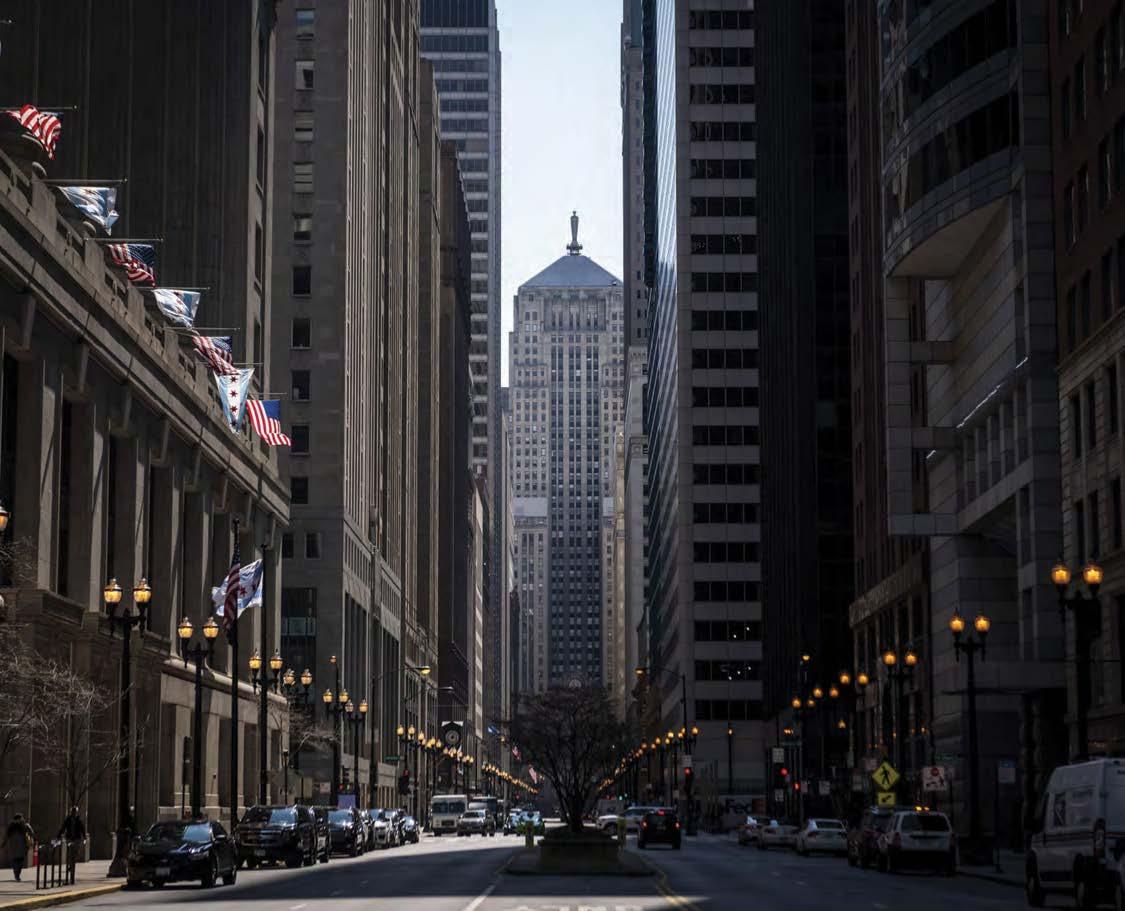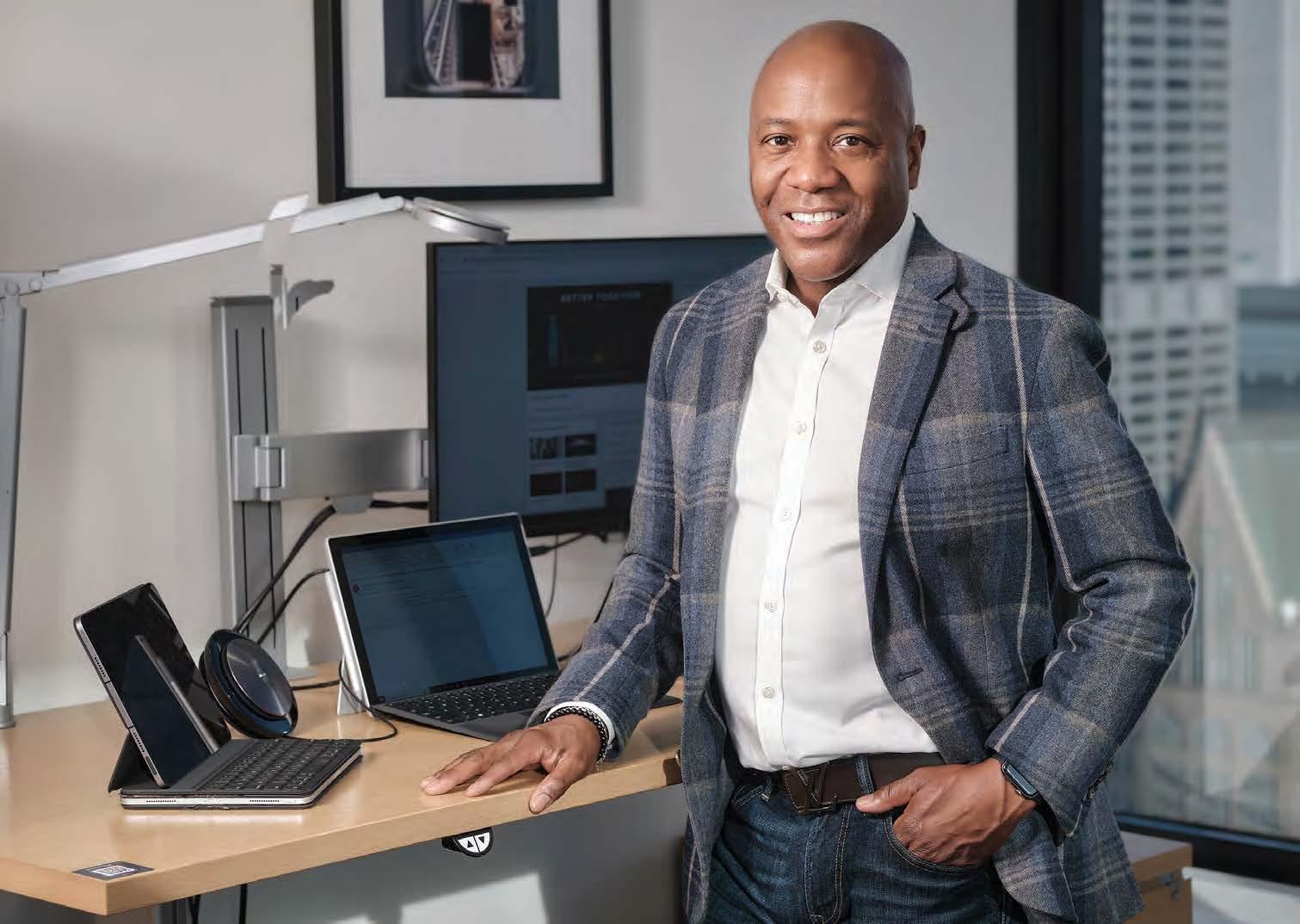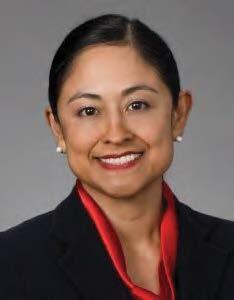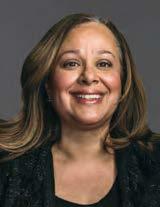OPTIMIZATION




CHICAGO’S RESTAURANT INDUSTRY shrank in 2022, as closures outnumbered openings in almost every month of the year.

It’s a sobering statistic. As COVID-19’s third anniversary nears, experts say that the restaurant recovery has been hampered by in ation and other headwinds.
e Chicago area had a net loss of 406 restaurants through the end of September, a 1.7% decrease from the prior year, ac-



cording to data from market research rm Technomic. In 2019, the restaurant industry grew by 638 locations, or 2.6%.
Yet the glum environment has not stopped operators in the inherently risky industry from opening new restaurants. But many say it has changed the economics of doing so. Food and labor costs continue



The nature of corporate board director recruitment often stands in the way of companies nding diverse board members
Newcomers o ering everything from po’ boys to omakase brave high costs and slim pro ts in an industry still struggling to recover from the pandemic I BY ALLY MAROTTIJOHN R. BOEHM Chef Stephen Gillanders of Valhalla
The rst time I saw one of those huge, modern windmills up close was ying into Copenhagen. I was headed to the Danish capital to cover the International Olympics Committee meeting that would award the 2016 summer games, and our ight path down to the airport maneuvered around and above huge white towers in the sea along the coast—towers that, even from the air, were enormous.
intended softies.
I’m leaning in favor. Our planet will be a toxic dust bowl if we wait for unanimity. Still, this matter needs a fair amount of additional vetting before it proceeds.
At issue is a bill sponsored by state Sen. Robert Peters and Rep. Marcus Evans, Democrats whose South and Southeast Side districts certainly could use the jobs and investment they say would come from operating a windmill farm 10 miles or so o Chicago’s southeast shore.
it a big push. Sponsors ran out of time, but Peters tells me he intends to reintroduce it later this month and press for a vote before the end of the Legislature’s spring session.

Chicago obviously didn’t get the Olympics bid, shoved aside by Rio. But the windmills may be coming here soon, and that’s setting o a pretty good debate over whether the giant towers are boon or bane, an a ordable, needed step toward ending our reliance on carbon fuel or a classic example of inside sharpies plucking the pockets of well-
eir measure speci cally would authorize a pilot wind farm of 10 to 12 turbines, producing 150 megawatts of energy, about what it takes to power 75,000 homes.
e bill had been lying around for a while before it caught a huge gust of wind (sorry!) late in the lame duck legislative session, when both the Black Caucus and the International Union of Operating Engineers Local 150 gave


Peters concedes the project— which is being pushed by, among others, Texas-based aquatic drilling giant Diamond O shore— would get a subsidy of up to $34 million a year for up to 20 years in the form of a surcharge on electric bills. “It’s de nitely worth it,” he says. “ is is a unique opportunity to transform our (electric) grid.” at subsidy gure draws particular ire from Illinois green leader Howard Learner, who runs the Chicago-based Environmental Law & Policy Center. A subsidy that could total $680 million is real, and perhaps unwise. because the cost of building in the water is ve to seven times what it would be onshore, he says. Yet, even Learner leaves the door open a crack. One big reason is that everybody in the green energy business—everybody gets subsidies. e big new energy
bill Illinois lawmakers enacted in 2021 allots $587 million in extra charges for green, renewable power producers just this year. Ergo, no one wears a white hat. Other reasons come from Aaron Greco, program manager of the wind energy lab at Argonne National Laboratory. In an interview with Yuki Hamada, who handles Argonne’s work on wildlife response to renewable energy development, both stressed that lots is still unknown and lots more research is needed. But, as Greco put it, “If you want to decarbonize, you have to start somewhere.”
In fact, he adds, while o shore production is more expensive than on-shore windmills, the cost is dropping quickly with improved technology, down 13%
just last year. Given that wind blows more strongly and steadily away from land, and given that production from solar generators is zero after the sun sets, “ e prospects of (harnessing) o shore wind is promising. As a country, we’re just so far behind.”
One other, somewhat smaller program recently won court approval to proceed in Cleveland. It has some nancial backing from the U.S. Department of Energy, which Peters says also may front some of the costs for his proposal here. A recent report from New York state also cited the potential of power from the Great Lakes.
So, we’ll see. But I’m from Illinois. Lawmakers, have someone produce a good, independent scal analysis of the numbers here before voting, OK?
Aordability is the biggest challenge facing the housing market today. And that means the most expensive housing markets in the country have seen a disproportionately larger decline in housing market activity.
Today’s a ordability crunch in expensive coastal cities creates an opportunity for the Midwest. As people look for new ways to overcome the home a ordability crisis, Midwestern markets—which tend to be relatively more a ordable—are expected to fare better than other similarly sized metro areas amid the current nationwide housing cooldown.
One reason is the advent of work from home, which appears likely to stick in many industries, o ering many workers and their families the opportunity to move to markets where space is less costly. ese cheaper markets are housing markets that tend to build more, where housing supply is more responsive to increases in demand.
is shift could—at least in theory—be a boon for a laggard Illinois economy that has seen its population shrink for nine consecutive years, including another record loss of nearly 142,000 residents to other states last year.
Unlike California and New York, where house prices and rents are out of reach for many because housing availability has historically failed to keep up with population growth, typical Illinoisans face much lower house prices when compared to their income.
e trouble in Illinois is that when you add property taxes to the cost of housing, the state is no longer on par with its Midwestern neighbors. In 2022, Illinois had the second-highest property tax rate in the country. Altogether, Illinois ranks fourth in the country
for the highest tax burden on residents when accounting for all state and local taxes—higher even than California, the state with the highest income taxes in the country.
According to Zillow, the typical home nationally is worth nearly $360,000, while the typical home in the Chicago metro area is worth less—roughly $310,000. For that, a Chicagoan would have paid approximately $7,000 in property taxes in 2022 compared to just $3,900 paid by the typical American. And Chicago-area property taxes are set to increase again.
For potential homebuyers, that would be an issue since monthly housing costs matter more for housing a ordability than the sticker price. e typical monthly mortgage payment is xed over the duration of the loan, while frequent tax increases can be a challenge for household budgets month after month.
To support homebuyers in understanding variability in monthly costs across markets and with fast-changing mortgage rates, Zillow has rolled out a new search tool that allows potential buyers to search for housing based on the all-in monthly cost they can a ord, rather than by list price. e new monthly cost estimator includes monthly mortgage payments as well as estimates for insurance costs, taxes and HOA fees, where present.
e cost of homeownership is not just the forgone interest that a homeowner could have earned by investing in something other than a down payment; it is also what has to be paid in mortgage interest and in state and local taxes—including property taxes.
e sharp increase in interest rates in 2022 has raised the cost of a down payment for potential homebuyers across the country.
And disproportionately higher state and local tax increases make the Chicago area an outlier in the Midwest and relatively less attractive than nearby metropolitan areas.
As in ation cools, downward pressure on mortgage rates is expected to thaw the housing market—faster in relatively more a ordable areas. Traditionally higher property taxes are associated with more public investments that improve local amenities. So


far, that hasn’t been the case in Illinois. However, if buyers could expect a bigger bang for their buck despite the higher tax burden, Illinois could also bene t from a Midwestern revival in 2023.
Let us get to know your business.


Oksana and Volodymyr Khamlin moved into a newly nished basement apartment in Logan Square last November, a month after arriving in Chicago from their home in war-torn Ukraine.
“It’s nice,” Volodymyr Khamlin told Crain’s through an interpreter, with “good appliances and across the street from a park,” Palmer Square.
e Khamlins’ new home is one of three basement apartments that developer Gabe Horstick added to nine existing units in the 1930s brick building on Kedzie Boulevard after buying it in July 2021. Horstick’s rm, Base 3 Development, was able to add the three because of the city’s twoyear-old ordinance allowing new additional dwelling units, or ADUs, including basement or attic apartments and detached coach houses, for
David Wallach, a Chicago builder who says he gets many inquiries from people outside the pilot zones
A top exec at the chain says ‘probably we put in too much’ when it comes to store security. But retailers and an industry expert say crime remains a big problem.
BY ALLY MAROTTIWalgreens’ anti-shoplifting e orts are paying o , and the Deer eld-based pharmacy chain plans to peel back some of its spending in that area. CFO James Kehoe told analysts this month that perhaps the company overdid it a bit.
“Maybe we cried too much last year,” he said during the compa-
ny’s earnings call. “Probably we put in too much and we might step back a little bit from that.”
But Walgreens’ experience is an anomaly, said Rob Karr, president and CEO of the Illinois Retail Merchants Association. Most other Illinois retailers continue to be plagued by retail theft, and there is no indication they are cutting back on the security measures they put in place.
“Everybody
comes to retail crime,” Karr said. “Retailers continue to have to make huge investments to oset the increasing numbers.”
Walgreens did not disclose how much it spent to combat retail theft, but it was among the cohort of retailers that ramped
Households and businesses usually have reason to worry when a utility asks regulators to approve a rate hike.
But there’s reason to hope that a $402 million rate hike request by Peoples Gas could ultimately save customers money by reining in a massive pipe replacement project that’s billions of dollars over budget and years behind schedule. e rate hike proposal that the Chicago gas utility led Jan. 6 with the Illinois Commerce Commission means the project will nally get the regulatory scrutiny it has largely escaped since it was launched in 2011. For years, Peoples has had a virtual blank check to spend what it pleases on the project and bill the costs to customers, with a nice pro t tacked on.
Carte blanche for Peoples opened the door to staggering cost overruns and delays. What started out as a plan to replace aging, potentially leaky gas pipes in Chicago turned into a boondoggle for Peoples’ customers and a boon for its Wisconsin-based parent company.

Costs related to the project helped push bills to the point that 1 in 5 residential customers struggle to a ord heating and cooking gas. And pro ts on pipe replacement work helped nance steadily rising dividends at Wisconsin Energy, which acquired Peoples in 2015.
As the project dragged on, it became clear that Peoples was doing more than simply replacing old pipes with new ones on a one-for-one basis. For example, it’s installing two pipes on streets previously served by one. And it’s upgrading the entire system to medium-pressure delivery from low-pressure.
Clearly, these expenditures drive up project costs. But are they essential to the safe and e cient delivery of heating gas to Chicago homes and businesses? Or are they costly bells and whistles that serve primarily to pad Peoples’ bottom line and keep dividends owing to Wisconsin Energy shareholders?
MANDATE
e ICC is supposed to make those types of determinations, as part of its mandate to protect Illinoisans from abuses by monopoly utility companies.
But the agency largely punted that responsibility for years under a deal that allowed Peoples to bill customers for pipe replacement work through a separate surcharge on their bills, rather than seeking approval to include those costs into the basic charge for delivering gas. e deal provided that the ICC would review the
appropriateness of the charges annually on an after-the-fact basis.
As my colleague Steve Daniels has reported, the ICC fell six years behind in conducting those reviews, leaving Peoples to its own devices. Not surprisingly, project costs surged and pipe-replacement progress slowed as the watchdog snoozed.
Currently, the project is on pace to cost $11 billion, more than ve times the original $2 billion estimate and well above Peoples’ current forecast of $8 billion.
Peoples has missed its annual pipe replacement goal every year since 2015, pushing the projected completion date ever farther away. At the current pace, work will nish in 2048, 18 years later than the initial target and eight years beyond Peoples’ latest estimate.
But Peoples’ long regulatory holiday may be ending. e company’s authority to levy the pipe-replacement surcharge expires at the end of the year, and state legislators closed out their latest session without extending it.
Reading the political tea leaves, Peoples rolled its pipe replacement costs into a garden-variety rate hike request. at triggers an a priori ICC review of the work Peoples wants to do, and the amounts it wants to charge customers for that work. e commission will also examine more than $200 million Peoples currently is collecting through surcharges, which re ects past spending and most of which hasn’t been reviewed.
Such a proceeding allows regulators to reject charges they deem unnecessary or inappropriate. Eliminating such charges could mean customers pay less over the long term.
Utility regulation is meant to ensure safe, reliable and a ordable supplies of essential commodities like heating gas by letting suppliers recover reasonably necessary costs plus a pro t, while protecting customers against excessive charges. ose goals can’t be achieved without thorough and fair regulatory reviews of proposed rates. It’s long past time the pipe-replacement project got one.
A full- edged rate proceeding will allow Peoples to make its case for the costs it wants to pass along to customers. Consumer advocates will have their chance to argue against any or all of those charges.
And the ICC will have a chance to play its proper role by weighing the evidence, deciding what work is necessary, and limiting any rate hike to the cost of doing that work.
“THERE’S DEMAND FROM ALL OVER THE CITY, IF WE WERE ALLOWED TO BUILD ALL OVER THE CITY.”Developer Gabe Horstick was able to add three basement apartments in a building that had nine existing units.
The city’s additional dwelling unit program, still in early stages, needs tweaks to bring on a wave of new a ordable housing, city o cials and developers say I
else reports the numbers continue to rise when it
 BY DANNY ECKER
BY DANNY ECKER
New York investment giant Apollo Global Management has taken control of the Board of Trade Building in the Loop and hired a Chicago developer to try to inject new life into the distressed landmark tower.
A joint venture of Chicago-based Glenstar and Los Angeles-based privateequit y firm Oaktree Capital Management last month transferred the 44-story office building at 141 W. Jackson Blvd. to an Apollo-led venture that provided the senior loan tied to the property, according to Cook County property records. The move completed a deed-in-lieu of foreclosure, sources familiar with the transaction said, meaning Glenstar and Oaktree handed the building to its lender rather than face a likely foreclosure lawsuit over defaulting on its $256 million mortgage.
The tower becomes one of the highest-profile downtown office buildings surrendered by its owner since the start of the COVID-19 pandemic, which fueled the rise of remote work and a barrage of office space cutbacks that have driven downtown office vacancy to an all-time high. That movement has devastated office property values, leaving some buildings underwater, or worth less than the debt their owners have borrowed against them. The soft market and rising interest rates have made it difficult for owners to refinance loans, pushing many office properties into financial distress or foreclosure.
The CBOT Building adds to an especially large wave of that distress along LaSalle Street. Several older, outdated office buildings on and near the Loop thoroughfare have lost large tenants and struggled to compete for new ones at a time when companies are craving amenity-filled offices that will help compel employees to show up.
But Apollo is betting on a resurgence of the central Loop—perhaps with a boost from Google as it plans to overhaul and occupy the James R. Thompson Center— and that the CBOT Building can compete for new tenants with a fresh round of capital improvements. The firm has hired Chicago developer R2 to oversee renovations at the building and explore non-office uses “to create a dynamic, mixed-use environment,” R2 Principal Max Meyers said in a statement.
“Ownership is committed to (making) a substantial investment in the building to attract and retain tenants,” Meyers said in the statement. “We have a full stack, integrated operating team that is going to be very aggressive to win deals. . . .We will embrace the architecture and history and complement it with modern amenities with a value proposition.”
R2 is best known for owning office buildings in the city and its work on and near Goose Island, where it recently redeveloped the former Morton Salt warehouse on Elston Avenue into a music venue known as the Salt Shed. The company is also partnering with a foreign investor to turn the upper floors of the
office building at 79 W. Monroe St. into apartments, in line with a broader effort by Mayor Lori Lightfoot’s administration to incentivize LaSalle Street residential conversions to help revitalize the Loop.
The 1.4 million-square-foot CBOT Building is 82% leased, according to real estate information company CoStar Group, slightly above average today for downtown office buildings. Financial derivatives exchange CME Group, which signed a 15-year, 148,000-square-foot lease in the building in 2012 when it sold it to a joint venture of Glenstar and USAA Real Estate, is the largest tenant.
Walking away from the historic property wipes out any equity that Glenstar and Oaktree had in the building, though the owners pulled in years of operating cash flow and were likely able to cash out with a windfall just before the pandemic.
Glenstar and USAA paid about $152 million in 2012 for the property and subsequently put $35 million into the building for technological and other upgrades. Glenstar then recapitalized the property in late 2014, swapping
out USAA for Oaktree and taking out a $160.8 million mortgage on the historic building, property records show.
Glenstar and Oaktree refinanced the building again with a new $178 million loan in May 2017, when it was appraised at $275 million, according to a Bloomberg report tied to the mortgage. A portion of that mortgage was packaged with other loans and sold off to commercial mortgage-backed securities investors, making much of the building’s financial information publicly available. The building generated $7.2 million in net operating income in 2018 off of about $30 million in top-line revenue, according to the Bloomberg report.
Then in 2019, with the downtown office market thriving, Glenstar and Oaktree tried to sell the property for a price they hoped would approach $330 million as investors clamored for office buildings downtown. But they never reached a deal and ultimately refinanced the property with the $256 million loan in
February 2020. Proceeds from that new loan were meant to help fund new leasing efforts, though it also allowed the owners to pocket some profits from the building’s appreciating value.
Apollo subsidiary Athene provided a $198 million senior loan to lead the debt package in 2020, property records show, and Meyers said in a statement the balance of that loan when it seized the property was roughly $168 million. The 2020 refinancing also included a $58 million mezzanine loan from Los Angeles-based CIM Group, which had a balance of roughly $49 million when the property was transferred last month, according to Meyers. A CIM spokeswoman did not provide a comment.
Spokesmen for Glenstar and Oaktree declined to comment.
Known for its open outcry trading pits and faceless aluminum statue of Ceres, the Roman goddess of agriculture, that stands atop its roof, the CBOT Building was built in 1930 and stood as Chicago’s tallest tower until 1965, when it was supplanted by the Richard J. Daley Center. The art deco tower, which has made cameos in movies like “Ferris Bueller’s Day Off” and “The Dark Knight” and served as the studio home for 1970s dance show “Soul Train,” was designated a Chicago landmark in 1977 and listed on the National Register of Historic Places in 1978.
The move adds to the wave of distress plaguing older o ce buildings along the LaSalle Street corridor IThe Board of Trade Building looms over LaSalle Street, where Mayor Lori Lightfoot’s administration aims to incentivize residential conversions to help revitalize the Loop.
THE CBOT BUILDING WAS BUILT IN 1930 AND STOOD AS CHICAGO’S TALLEST TOWER UNTIL 1965, WHEN IT WAS SUPPLANTED BY THE RICHARD J. DALEY CENTER.BLOOMBERG

When your company thrives, it helps Chicago communities thrive too. That’s why we’re introducing a first-of-its-kind grant to help you purchase commercial property.
Learn more at bankofamerica.com/DownPaymentGrant
You may qualify for a Down Payment Grant up to $25,000
IMPORTANT TAX INFORMATION: Our grant can be considered taxable income by both state and federal authorities, which means, you may owe more in taxes. If you choose to accept this grant, we’re required to report the funds we gave to you to the Internal Revenue Service (IRS) on Form 1099-MISC. We’ll also send you a copy of this form for your tax records. We will need a copy of your W-9 to determine your tax implication. Before accepting this grant, we’d recommend you talk with a tax advisor.
The Down Payment Grant is available only for qualified women-owned and minority-owned business applicants for Small Business Administration (SBA) 504, SBA Express and 7(a) loans, who are purchasing owner-occupied commercial real estate within an opportunity zone. Qualified recipients must certify that business entities (including sole proprietorships) are at least 51% owned by women, Black or African American, Hispanic or Latino, Native American or Alaska Native, Asian, Native Hawaiian or other Pacific Islander. Program funds can be applied toward down payment only. Borrowers cannot receive program funds as cash back in excess of earnest money deposits. The Down Payment Grant program is only available with the SBA 7(a), SBA Express and SBA 504 products. Down Payment Grant program may be considered taxable income and a 1099-MISC will be issued; consult with your tax advisor. The commercial real estate loan must fund with Bank of America. Down Payment Grant may only be applied once to a qualifying owner-occupied commercial real estate, regardless of the number of applicants. Bank of America may change or discontinue the Bank of America Down Payment Grant Program or any portion of it without notice. Not available with all loan products, please ask for details. Credit and collateral are subject to approval. Terms and conditions apply. This is not a commitment to lend. Programs, rates, terms, and conditions are subject to change without notice. May be combined with other offers. If you do not qualify for the Down Payment Grant, you may still apply for SBA loan products, as well as for other non-SBA loan products of Bank of America. Owner-occupied commercial real estate will be determined in underwriting and requires occupancy by the borrower/guarantor. Please note SBA guidelines require at least 51% occupancy to be considered Owner Occupied. SBA financing is subject to approval through the SBA 504, SBA Express and SBA 7(a) programs. Loan terms, collateral and documentation requirements apply. Bank of America credit standards and documentation requirements apply. SBA eligibility and restrictions apply.
of America and the Bank of America logo are registered trademarks of Bank of America Corporation. ©2023 Bank of America Corporation. All rights reserved | MAP5102753
Bank BY BRANDON DUPRÉ
BY BRANDON DUPRÉ
e Pritzker Traubert Foundation announced Sankofa Wellness Village in West Gar eld Park as the winner of its second Chicago Prize, a grant competition that provides capital to initiatives that focus on creating lasting change in historically disinvested neighborhoods.
e Sankofa Wellness Village—an initiative that will bring wellness, art, business and other opportunities and services to the Madison and Pulaski commercial corridor—will receive a $10 million grant that will go toward helping the group behind it see through the estimated $50 million project.
“What was really compelling in West Gar eld was both the proposal itself but also that it was a community-led team. e project was very much part of what the community wanted and asked for and added this really interesting collaboration with institutions,” said Cindy Moelis, president of the Pritzker Traubert Foundation.
Gar eld Park Rite to Wellness Collaborative will lead the project with a coalition that includes “New Mount Pilgrim Missionary Baptist Church, West Side United and the Community Builders as well as health and nonpro t partners: Rush University Medical Center, Erie Family Health Centers and the YMCA of Metropolitan Chicago,” among others, the foundation said.
“ is neighborhood has been kind of a stepchild of the city for far too long,” said Marshall Hatch Jr., a minister at New Mount Pilgrim Missionary Baptist Church and member of the Gar eld Park Rite to Wellness Collaborative.”I think this is the rst major investment in this neighborhood in over 50 years and we’re just excited to be conduits in the center and be part
of this movement that has been brewing in this neighborhood, this renaissance of West Gar eld Park.”
e Erie Family Health Center plans to provide more than 6,000 patients annually with comprehensive health care services, and a partnership with the YMCA will o er tness activities and child care programs at the new development.
Other planned components of the project include arts and job training by the MAAFA Center for Arts, the opening of a new credit union to serve the local community and new grocers to provide healthy food options for residents.
“Chicago is our home, and we all need to be in this together,” said Bryan Traubert, who leads the foundation with his wife, billionaire and former U.S. Commerce Secretary Penny Pritzker. “Philanthropy and business and government are pivoting and need to pivot to look at community development in disinvested neighborhoods, particularly on the Southwest, South and West sides and neighborhoods of color.”
e Sankofa Wellness Village was one of six nalists, all of which the Pritzker Traubert Foundation provided with $135,000 in planning funds to develop their proposals.
e Pritzker Traubert Foundation and We Rise Together, a project housed at the Chicago Community Trust that seeks to help Black and Latino communities, will each provide $2.5 million in grants to the other nalists. e Pritzker Traubert Foundation added that it will continue to work with business and philanthropic leaders to increase that number.
e Chicago Prize initiative is part of a $100 million commitment the Pritzker Traubert
Foundation has made to increase economic opportunity and community wealth “via the built environment in Chicago.” e foundation said that, through philanthropic, corporate and civic partners, it raised over $60 million in development funds for its rst Chicago Prize in 2020.
Always Growing, Auburn Gresham was selected as the inaugural recipient of the Chicago Prize. e initiative is led by the Greater Auburn-Gresham Development Corp., Urban Growers Collective and Green Era Partners and includes a rst-of-itskind natural renewable gas project on Always Growing’s campus at 650 W. 83rd St.
e seeds of what would become the Chicago Prize began while Bryan Traubert worked as president of the Chicago Park District. ere, he would regularly listen to community members around the city about what they wanted most for their parks and neighborhoods.
“ e problem was the ideas were abundant and the funds weren’t,” Traubert said. To help nd a solution to this problem,
Traubert, along with Pritzker and others, came up with the Chicago Prize.
“ e Chicago Prize became our mechanism for an open call,” said Moelis, the foundation president. “It democratized the idea that anyone who was willing to share their idea with us could send us a three-page letter of intent.”
e foundation said that, within the next two to three years, it is committed to a third Chicago Prize. It could not provide further details at this time.
More about the other nalists:
Cultivate Collective in Gar eld Ridge: e project will stimulate economic development and generate local wealth through job training, business incubation, homeownership assistance, education and employment on the Southwest Side.
The Xchange in Greater Grand Crossing: e project will bring tech jobs, workforce training opportunities and health initiatives together in an ambitious
real estate plan.
Rooted & Rising in Back of the Yards: Led by the Back of the Yards Neighborhood Council, the project will “provide critical a ordable housing, new commercial space for nonpro ts, a performing arts theater, and other uses to promote wealth building and support services to residents.”
Bringing Communities Back Initiative in the Far South Side: Spearheaded by Far South CDC, the program will “draw residents back to Greater Roseland through the repurposing of nearly 1 million square feet of space for residential and retail uses, investments in minority contractors, home ownership programs, and small grants to residents and businesses.”
Thrive Exchange in South Shore/ South Chicago: “A multi-faceted development led by DL3 Realty and Chicago Family Health Centers that’s focused on improving public health outcomes through workforce development, housing, and strategic placemaking.”
Chicago just surpassed New York City.
Well, that’s at least the case when it comes to cities with the most tra c congestion. Chicagoans were more impacted by time spent in tra c in 2022 than drivers in any other U.S. urban area, according to the latest annual report from transportation analysis rm Inrix.
Drivers in and around the city lost 155 hours sitting in tra c last year. at’s up from 104 lost hours in 2021, which earned the area the No. 2 ranking behind New York City.
e “hours lost” gure represents the average addition-
al time travelers spent on the road during peak congestion hours compared to the time they would’ve spent driving had there been no tra c.
Across the U.S., the average driver lost 51 hours to tra c congestion, a 15-hour increase from 2021. London is the only city in the world where commuters are more impacted by tra c than in Chicago. Paris, Boston and New York City make up the rest of the top ve this year.
Most urban areas continue to see tra c congestion well below pre-pandemic levels. at’s not the case in Chicago, though, where congestion delays are 7%
higher than before the pandemic. Of the 20 U.S. cities most impacted by congestion this year, Miami is the only other area where congestion is worse now than it was in 2019.
Chicago is also unique in that it did not see a drastic yearover-year increase in trips to its downtown area. Whereas cities like Boston, Detroit, New York and Washington, D.C., saw double-digit percentage increases to their central business districts, downtown trips in Chicago increased just 1% over the last year.
at’s at least in part the result of Chicago’s strong o ce-going trend in 2021.
Crain’s reports that Chicago’s return-to-o ce levels are cur-
rently slightly ahead of the national average and on par with New York and Los Angeles after the end-of-year holidays.
Despite the uptick in street tra c congestion, overall commute times in the city are down an average of 3.2 minutes since 2019. Experts attribute this in part to the fact that while vehicle tra c has gone up overall, there remains a decrease in congestion during peak morning and afternoon rush-hour times.
Chicagoans looking to further shorten their travel times can do so by shifting the time they leave their homes. e busiest departure times in Chicago are 7 a.m.-
7:30 a.m. and 8 a.m.-8:30 a.m., when roughly 27% of the city’s nearly 1 million commuters leave their homes. ose who typically leave for work in either of these time slots can save up to four minutes per day if they shift their departure time to the less busy 7:30 a.m.-8 a.m. period, according to a recent study.
Inrix estimates that commuters in Chicago paid $953 for fuel to commute to work in 2022, a 34% increase from the prior year. e national increase was a comparable 32.5%.
e report speci cally tracks trips to cities’ major employment centers from their surrounding suburbs and does not include suburb-to-suburb tra c.














PremiStar is the new name for 15 of the leading HVAC, plumbing, and building controls service providers in the Midwest. We o er a comprehensive range of services including 24/7 emergency repair service, preventive maintenance, design/build project services, controls, and plumbing. With more than 400 HVAC technicians, we have one of the largest, most diverse, and technically proficient team of experts in the Midwest.


To learn more, visit PremiStar.com/IL







The four sales at $5 million or higher are further evidence that the extreme upper end isn’t slowing down like the rest of the market
BY DENNIS RODKINIn the new year that has just started, at least four homes have already sold for at least $5 million each, one each in Lake Forest, Winnetka, the Gold Coast and Lincoln Park.
It’s another sign that the extreme upper end of the Chicago-area housing market has stayed hot while other segments of the market, including homes priced at $1 million and up, have cooled.
In the past two years, the upperend market has blown past all previous records. In 2022 there were 134 sales of homes at $4 million or more, according to Crain’s preliminary count. at’s an increase of almost 33% above the 101 sales in 2021, which was almost double the average number of sales in the previous six years.
e highest-priced sale of the edgling year is a Lake Forest estate that sold Jan. 10 for $5.75 million. It sold fast. e 2.2-acre property on Blu s Edge Drive came on the market at just below $6 million on Sept. 12 and landed a buyer in a week, according to listing information posted by Elizabeth Wieneke, the Compass agent who represented it.
Wieneke declined to comment beyond con rming that the house had been extensively renovated since it last sold, in 2011 for $2.1 million.
e sellers, identi ed in Lake County records as Arlington and Karen Guenther, could not be reached. e buyers are not yet identi ed in public records and their agent, Karina Kolb-Formento of @properties Christie’s Interna-
tional Real Estate, did not respond to a request for comment.
e Blu s Edge property is an unusual combination of structures from two historical eras in di erent styles.
One is a stone blu -top balustrade and brick terrace lled with formal gardens, a Mediterranean-inspired remnant of the 80acre Walden Estate built in the late 19th century for Cyrus McCormick Jr. and his wife, Hattie. e other is the house, a sleek white modernist design by John Black Lee, built in 1961. Photos of the house were removed from the listing when the sale closed, but a Chicago magazine article from 2011 said the house had “walls of windows and several skylights that looked out onto the surrounding trees and lake vistas.”
e year’s rst high-end sale closed Jan. 3, when buyers closed their $5.2 million purchase of a ve-bedroom lakefront home on Sheridan Road in Winnetka.
e buyers are not yet identi ed in public records, and it’s di cult to get a clear picture of the sellers from the records. According to the Cook County clerk, a limited liability company bought the property in August for $4.175 million. at means the LLC scored about $1 million in reselling the property ve months later.
A representative of the LLC could not be located, and the agents involved in the January sale, Jena Radnay of @properties Christie’s International Realty for the seller and Catherine Caravette of Conlon Commercial for the
buyers, did not respond to multiple requests for comment.
e house, a 4,400-square-foot Colonial built in 1962 on threefths of an acre, looks like a potential teardown candidate, but Crain’s couldn’t con rm that.

Several upper-priced homes on the North Shore lakefront have been teardowns recently, including one half a mile from this home that sold for nearly $12.8 million in August and the string of four homes bought by billionaire Justin Ishbia.
e year’s second $5 million-plus sale, which closed Jan. 9, was a ve-bedroom unit in a historical co-op building on Lake Shore Drive. Buyers paid $5.2 million for the 18th- oor unit at 1500 N. Lake Shore.
Designed by Rosario Candela, the architect of several top- ight cooperative buildings in New York City, and completed in 1927 during the Jazz Age heyday of high-end Lake Shore Drive living, the building has housed Wrigleys, McCormicks, Donnelleys, Fields and others with prominent Chicago names.
Crain’s could not determine who the seller of this unit was, because owners in cooperative buildings own shares of the building and are mostly not identi ed in county property records.
e sellers were represented by two agents from @properties Christie’s International Real Estate, Joelle Cachey Hayes, who declined to comment, and Suzanne Gignilliat, who did not respond to a request for comment. Maureen Moran, also of @properties Christie’s International Real Estate, who
represented the buyers, did not respond to a request for comment.
In photos that accompanied the listing, the unit appears to have some original nishes, including handsome wood paneling and stone replaces, a black dining room oor emblazoned with gold suns, and built-in bookcases. e listing notes that the unit has 75 feet of windows. e unit came on the market in August at $5.6 million and went under contract in November.
In the third high-end sale, buyers paid $5 million Jan. 9 for a house on Dayton Street in Lincoln Park.
It’s likely the buyers will end up spending more than the purchase price, as the builder and the listing agent both con rmed the sale was of an un nished house. e buyers’ names are not yet in public records, and their agent, Susan Nice of Dream Town Realty, did not re-
spond to a request for comment.
In January 2022, LG Development unveiled its plan for a massive revamp of a Tuscan-style mansion on the lot, which an LG entity purchased for $3.35 million in 2021. At the time, LG was o ering either the remodeled 8,500-square-foot house at $7.2 million or, for more than $10 million, the house plus a lot that was for sale next door, added to this one and with a new pool installed.
e sale that closed last week did not include the next-door lot and was for the house with its rehab only begun, LG principal Brian Goldberg and Jameson Sotheby’s International Realty agent Lauren Goldberg both con rmed. Brian Goldberg said the house has been gutted, but other than new windows and roof, it does not contain any nishes. e buyer will select a look, which may or may not be the California-in uenced modern style that LG showed for the property a year ago.
e co-founders of Gold Coast steakhouse Maple & Ash have settled their 10-month-long court battle and plan to divvy up their nationwide restaurant portfolio.

Jim Lasky and chef/partner Danny Grant, who has not been involved in the lawsuit, will retain ownership and operational control of Maple & Ash locations in Chicago and Scottsdale, Ariz.; Italian restaurant Monarch and sushi and sake lounge Kessaku, which are both in Dallas; and any future opportunities for those brands. David Pisor and chef/ partner Daniel Perretta, who also has not been involved in the suit, will take ownership and control of the Etta brand—which has locations in River North and Bucktown in Chicago; Culver City,
Calif.; and Scottsdale—and Cafe Sophie in Chicago through a new venture.
Financial terms of the settlement were not disclosed.
Pisor rst sued Lasky in Cook County Circuit Court last March, alleging Lasky locked him out of corporate o ces and disabled electronic access to nancial reports after Pisor refused a demand to sell his stake. Since then, the parties have appeared many times in court and leveled new allegations against each other. ere were accusations of secret bank accounts and default notices from landlords.
Additionally, at least two of the restaurant group’s locations closed throughout the course of the court battle, and the suit was consolidated
with another lawsuit that outside investors led against the co-founders.
e lawsuit involving outside investors will continue, though settlement discussions have been ongoing. Michael Forde, an attorney representing the outside investors, declined to comment on Lasky and Pisor’s settlement.
Lasky said in a statement this month that he and Grant are “relieved” the lawsuit has been resolved.
“ ere’s no question our teams will continue to put the same work, passion and energy into these restaurants that made them successful from the outset as we take full control and resume our expansion,” Lasky said in the statement.
Pisor also expressed relief over the resolution of the disagreement. “I’m excited about the op-
portunity to build a collection of the best restaurants around the country again.”
e two partners opened Maple & Ash in 2015, and it grew to become one of the state’s top-grossing steakhouses. It was
Pisor and Lasky’s rst venture together. e original complaint said revenue for parent company What If Syndicate was expected to approach $200 million in 2022. Grant and Lasky’s venture will get a new name.
Here’s what it took to bring one of the Chicago restaurant industry’s nastiest court battles to a conclusion after 10 months of back-and-forth allegationsMaple & Ash co-founder David Pisor and chef/partner Daniel Perretta, who has not been involved in the suit, will take ownership and control of Etta, which includes this location in Wicker Park.
We’ve all seen it: the “Shark Tank” presentation so impressive that all the sharks are clamoring to invest. ese pitches tend to be highly polished—the entrepreneurs present con dently and awlessly, touch on every aspect of the business, and anticipate questions from the investors before they are even asked. What separates these entrepreneurs from the prepared and well-intentioned contestants whose pitches fall at?

While some of what goes into these presentations is learned through undergraduate or MBA coursework, there is also much that is not captured in a syllabus.


Entrepreneurship’s “hidden curriculum” refers to the norms, values, beliefs and mores that form the culture of business, and especially guide practices of pitching for investment capital and selling.
For example, investors expect the entrepreneur to know how to talk about their business: to describe the problem they are solving, outline their solution (i.e., what the business does), describe how many customers might buy the solution and predict how much money the business could make with their strategy to acquire customers.
Investors also expect the entrepreneur to follow the social norms of business presentations; this means speaking con dently, listening while maintaining eye contact and answering a question thoroughly (and then also answering the question that they wish had been asked).
In many cases, the hidden curriculum—in other words, the cultural norms of entrepreneurship— are both imperfect and always changing. Understanding normative practices can help new entrepreneurs navigate consequential situations, and can also reveal opportunities for innovation and new models and approaches.

To access this hidden curriculum, new entrepreneurs can:
Learn from the pros.
Watch pitches for early-stage ventures and presentations from executives at publicly traded companies to see and hear how leaders communicate about their businesses.

Don’t just record what they say, but also how they say it. What tactics do they use in answering questions?
Make low-risk mistakes.
Assume there is specialized language to describe business models and functions, and make as many low-risk mistakes as possible as you
Abigail Ingram,left, is executive director of the Polsky Exchange, and Erika Mercer is executive program director at the University of Chicago Booth School of Business’ Polsky Center for Entrepreneurship & Innovation.

area of expertise. Be authentic in how you communicate and emphasize your knowledge and di erentiators that align with the business’s core competencies.
develop your business. Practice using new language and messaging in low-risk conversations with mentors or professionals who are not likely to be customers. Don’t be afraid to ask for direct feedback: Are there ways they would expect your ideas to be communicated? Also, avoid jargon outside of your
Test your messaging. Take a scienti c approach, and develop a few di erent ways of talking about your business. Test out those scripts with various audiences. Pay attention to their responses and questions, and note which messages resonate with which audiences.
Hire strategically to ll in gaps. Understanding and accessing the hidden curriculum does not mean that you need to become an expert
in everything. Identify your strengths and hire or contract people who are not like you; if you are an excellent communicator, bring on a quant, and if you are a quant, nd a poet.
Finally, ask when you don’t know. Most successful people love to talk about their areas of expertise. One key business school lesson is that you never want to be the smartest person in the room. When you nd yourself surrounded by people with intelligence and experience that are intimidating, you have found yourself in the right place. Take the opportunity to ask questions so you can learn things that you do not yet know— and won’t know without asking.
“We don’t want nobody nobody sent.”
It’s a phrase from Chicago lore, uttered, as legend has it, through a fog of cigar smoke. e inestimable value of connections, the tacit agreement to unspoken and time-honored rules, the bond of silence: is was e Chicago Way, a political culture built on back-scratching and horse-trading, where serving the public interest, when that happened, was a happy but accidental side effect of the real business at hand.
We got an uncanny glimpse of how the legendary Machine’s gears turn on Jan. 11, when a team of prosecutors led by U.S. Attorney John Lausch laid out the case they intend to make in the March trial of ex-Commonwealth Edison CEO Anne Pramaggiore and others who stand accused of conducting an in uence-peddling campaign involving now-indicted former House Speaker Michael Madigan.
Madigan is, of course, the Chicago power broker long thought to be untouchable—that is, until Lausch came to town.
Lausch, Chicago’s U.S. attorney since 2017, did more than perhaps any single person before him to dismantle a political hierarchy that treated public money as its own and doled out favors, jobs and access to those willing to uphold the status quo. At ComEd, Pramaggiore, lead lobbyist and Madigan crony Michael McClain, and outside lobbyists John Hooker and Jay Doherty are accused of doing all they could to stay in Madigan’s good graces while his chamber crafted legislation that

would be bene cial to the Chicago utility. ComEd, judging by what we’ve learned, was a target-rich environment for a pol like Madigan seeking to cement his power.
e company’s fortunes were, after all, dependent on favorable treatment in Springeld. Its board seats were lucrative, paying in the neighborhood of $80,000 a year; its vast o ces could house many a politically connected sta er; the unionized workforce within its ranks could potentially be utilized as an election season army. ose
assets, as it turned out, were valuable currency in the halls of the Statehouse.
What’s striking about the 126-page document released by Lausch’s o ce is how vivid it is. It depicts not a Chicago of the Paddy Bauler era but the Chicago of the not-so-distant past, involving recognizable names and faces from present-day headlines. Indeed, Lausch has been a busy man since then-President Donald Trump gave him the top law-enforcement o cer job in Illinois. From the earliest months of
his tenure, Lausch oversaw a wide-ranging investigative e ort that ultimately led to indictments of a raft of pols, including 14th Ward Ald. Ed Burke, deemed “thoroughly corrupt” by Team Lausch. Other former elected o cials to face charges under Lausch’s watchful eye: omas Cullerton, Martin Sandoval, Emil Jones, Terry Link, Ricardo Munoz, Luis Arroyo, Patrick Daley ompson, Carrie Austin and more. But the ComEd case—as well as the trial of Madigan, now expected to begin in April 2024—will likely be remembered as the cornerstone of his work as Chicago’s top prosecutor. And while he would no doubt express con dence in his lieutenants’ abilities to carry on the prosecutions without him, Lausch’s just-announced plan to depart the o ce in late February or early March opens a void that must be lled—and quickly—with someone possessing outstanding quali cations, an un inching dedication to justice, and a reputation for integrity. Illinois’ two U.S. senators, who will play a key role in nominating Lausch’s replacement, have promised as much.
ere’s a lot riding on getting this pick right. e most important consideration at such a high-stakes moment for a city and state in dire need of reform is that the next U.S. attorney be someone of sterling character, someone who has no ties to the political structure around here, and someone who demonstrates a fearless drive to hold elected o cials to account.
In other words, we don’t want nobody somebody sent.
As a retired physician reading “Reinventing Walgreens” (Dec. 19), I was struck by the myriad of headwinds facing major pharmaceutical companies who are competing to enhance their topline growth while also vertically integrating their organizations by attempting to expand into primary care.
It makes sense to have physician extenders available to provide urgent care to conveniently handle minor medical problems such as soft tissue injuries like sprains and minor lacerations. However, expanding into primary care is another animal altogether.
Primary care is provided by family medicine and general internal medicine physicians who appreciate lifelong relationships with patients managing chronic conditions. The patient appreciates the consistency of the provider’s care over years rather than the convenience of an episodic visit to a neighborhood retail outlet. Also, there is a national shortage of primary care physicians, with no anticipated improvement in the pipeline from medical schools and residency
training programs.
As major health care systems are also working to increase the source of new patients entering their systems, they are also competing from the pool of fewer primary care providers. Also, as the article points out, primary care providers rely on a cadre of their trusted specialists for further system speci c care, and assuming this ideally seamless hando will occur given potential business con icts is unrealistic.
is continuity of care is also reliant on an electronic health record with interoperability, which is currently rare. Finally it is my experience that primary care physicians represent the best example of the ideal physician-patient relationship where the con icts of interest of the corporate practice of medicine will be problematic to the provider considering where to practice medicine.
I will watch from the sidelines as these large pharmaceutical rms compete and strive for a positive ROI on this strategy.
DR. DOUGLAS PROPP Naples, Fla.
Recent pieces in the media across the country concerning the FTX saga are often right on the law, but wrong on what the failure of the cryptocurrency exchange means for the cryptocurrency industry.
Financial regulators in the U.S. already have the tools they need to deal with the overnight cratering of Sam Bankman-Fried’s cryptocurrency exchange FTX as well as associated hedge fund Alameda Research. What is problematic in assessing the way forward for this new industry is in di erentiating between what cryptocurrency is and what businesses like FTX do.
Cryptocurrencies can be thought of as exclusive claims on assets that exist on a shared ledger maintained by a community of participants that may or may not know each other that allows for peer-to-peer value transfer.
e way these networks are designed allows for unique digital property to be exchanged in a peer-to-peer manner without
Write us: Crain’s welcomes responses from readers. Letters should be as brief as possible and may be edited.Send letters to Crain’s Chicago Business, 130 E. Randolph St., Suite 3200, Chicago, IL 60601, or email us at letters@chicagobusiness.com. Please include your full name, the city from which you’re writing and a phone number for fact-checking purposes.

the need for a central counterparty. at is the innovation that was introduced by Satoshi Nakamoto with the publishing of the Bitcoin white paper in 2008.
SBF created a company that allowed individuals to come together to buy and sell cryptocurrencies and related nancial products based on cryptocurrencies. In this way, FTX was much closer to the Chicago Mercantile Exchange than anything else, and it is apropos that CME CEO Terry Du y recently called out the way that SBF and FTX did business. e failure of FTX was a failure of centralized entities that function as middlemen to facilitate transactions for customers. It was not a failure of cryptocurrency writ large.
Where the industry goes from here in the wake of the failure of FTX is an open question, but the value proposition of peer-to-peer value transfer of digital assets without relying on a central counterparty is still extremely promising.
NELSON M. ROSARIO Adjunct law professor, Chicago-Kent College of Law Founder and partner, Rosario Tech LawSound o : Send a column for the Opinion page to editor@ chicagobusiness.com. Please include a phone number for veri cation purposes, and limit submissions to 425 words or fewer.
This most recent property tax hike, requiring residents to come up with thousands of dollars in mere days, is cruelty unheard of. Now with property tax bills doubling and more in the future, such as ours in Humboldt Park, it will destroy the city, causing gentri cation to explode.
How to stop it? It’s a cause and e ect: Fix the property tax system. Now. It’s shattered beyond belief and these increases are intensely shortsighted for Chicago’s future and viability.
Stop tying bills to a speculative real estate market. My paycheck does not speculatively increase to cover these bills because my house value supposedly went up. Shoving out residents who ll jobs and provide services, forc-
President/CEO KC Crain
Group publisher/executive editor Jim Kirk
Editor Ann Dwyer
Creative director Thomas J. Linden
Director of audience and engagement
Elizabeth Couch
Assistant managing editor/audience engagement Aly Brumback
Assistant managing editor/columnist Joe Cahill
Assistant managing editor/digital content creation Marcus Gilmer
Assistant managing editor/digital Ann R. Weiler
Assistant managing editor/news features
Cassandra West
Deputy digital editor Todd J. Behme
Deputy digital editor/audience and social media Robert Garcia
Digital design editor Jason McGregor
Associate creative director Karen Freese Zane
Art director Joanna Metzger
Copy chief Scott Williams
Copy editor Tanya Meyer
Contributing editor Jan Parr
Political columnist Greg Hinz
Senior reporters
Steve Daniels, Alby Gallun, John Pletz
Reporters
Katherine Davis, Brandon Dupré, Danny Ecker, Jack Grieve, Corli Jay, Justin Laurence, Ally Marotti, Dennis Rodkin, Steven R. Strahler
Contributing photographer John R. Boehm
Researcher Sophie H. Rodgers
Senior vice president of sales Susan Jacobs
Vice president, product Kevin Skaggs
Sales director Sarah Chow
Events manager/account executive Christine Rozmanich
Production manager David Adair Events specialist Kaari Kafer
Custom content coordinators
Ashley Maahs, Allison Russotto
Account executives

Claudia Hippel, Bridget Sevcik, Laura Warren
Sales administration manager Brittany Brown
People on the Move manager Debora Stein
Digital designer Christine Balch
Keith E. Crain Chairman
Mary Kay Crain Vice chairman
KC Crain President/CEO
Robert Recchia Chief nancial o cer
Veebha Mehta Chief marketing o cer
G.D. Crain Jr. Founder (1885-1973)
Mrs. G.D. Crain Jr. Chairman (1911-1996)
For subscription information and delivery concerns please email customerservice@ chicagobusiness.com or call 877-812-1590 (in the U.S. and Canada) or 313-446-0450 (all other locations).
ing people to seek more a ordable housing in less-expensive areas, spreads gentri cation like a weed. at could be what the city wants, though: all its residents except the wealthy to leave. Who will work in restaurants? Who will drive the buses? Who will run the shops, provide services, police our streets? No one.
We’re not ATM machines with unlimited balances. Keep the city viable and workable for residents, or no city will be left.
BECKY MARSHALL ChicagoI’m absolutely befuddled how a newspa-
per purportedly about business fails to include a single opinion piece regarding how the marketplace is the best solution to address the lack of a ordable housing (Crain’s Forum on a ordable housing, Dec. 19).
Your articles consistently beat the drum concerning the need for more government involvement and more subsidies. Aside from the almost shockingly bad experience Chicago has endured with public housing, perhaps one writer could have been asked to address how the government actually gets in the way of solutions to a ordable housing—e.g., rigid regulations pushing up the cost to construct housing.
Ironically, one of the reasons the cost of
housing in Chicago is in fact dramatically less expensive than the coasts is because we have much less of a NIMBY approach toward new construction. We are witnessing thousands of new units being constructed throughout several neighborhoods, while simultaneously the population is not growing and potentially is on the decline. is new construction will ultimately keep a lid on price growth among the total housing base.
I think your readers would bene t by having the city’s leading business publication on occasion defend how a marketplace can function by marketplace actions.
BARTON LEWIN ChicagoUnited Airlines unveiled a new lounge at O’Hare International Airport, with more space, better food and a view of the action on the tarmac from the bar.
At 17,000 square feet and with more than 400 seats, the new United Club on the C Concourse in Terminal 1 is twice the size of the lounge it replaces.

United joins Delta among airlines that are upgrading the lounges and clubs that are used as perks to give customers a respite from some of the hassles of air travel. The pandemic raised the stakes for airlines to improve amenities for their best customers and refocus on travelers who fly the most and spend the most. Delta recently opened a new Sky Club Lounge in Terminal 5 at O’Hare.
“The arms race for the passenger now is in the lounge, not on the airplane,” says Henry Harteveldt, president of Atmosphere Research Group in San Francisco. “Unlike so much of the airline business, which is a race to the bottom, they’re racing upward with the lounges. The quality is getting better, comfort is getting better, amenities are getting better.”
The new club is the largest of three United lounges in Terminal 1, its main facility at O’Hare. United Clubs are available to
members of its Mileage Plus frequent-flyer program, who pay an annual fee of $650 or use frequent-flyer mileage. Customers also can pay a one-time fee of $59. Holders of certain Chase credit cards affiliated with Mileage Plus also get to use the clubs. Access is complimentary for customers traveling in business class on transcontinental flights.
United, like other carriers, also offers an even more exclusive club for international business-class travelers called the Polaris Club.
The new United Club at O’Hare is one of several opened by United around the country at airports in Phoenix and Newark. All the major airlines are in the process of upgrading their airport lounges and clubs.
“This is fantastic,” said Erin Finley, a longtime United flyer who got a sneak peek at the new lounge. “It almost looks like a magazine shoot. This is almost as nice as the Polaris Lounge.”
The two big changes are food and seating, says Alexander Dorow, who oversees clubs and lounges at United. “There’s more privacy, elbow space and better circulation around the club.”
Because O’Hare has less concessions space than many air-
ports, United bumped out the terminal to accommodate the new club, which allowed it to add a full kitchen and offer a buffet featuring hot meals. The menu features more fresh-food items that travelers can customize, as well as a rotating menu of Chicago favorites such as Italian beef and sausage sandwiches. The club also features works by Chicago artists.
Clubs are just one sign of the ways in which COVID-19
changed air travel. The convenience of Zoom meetings and a sluggish economy threaten to reduce business travel coming out of the pandemic. But many of those former road warriors, as well as worker bees whose ability to fly was limited by their vacation time, have more time for leisure travel because of remote work. They still want the amenities they enjoyed for business travel.
United and other airlines
also found during the pandemic that the frequent-flier credit card programs were surprisingly resilient and lucrative. So it makes sense to increase creature comforts.
“It’s all because this is good business,” Harteveldt says. “Lounges are a critical part of how airlines attract and keep premium customers. While ages ago they were viewed more as a service, today they’re very much a profit center.”
e U.S. Securities & Exchange Commission has charged former McDonald’s CEO Steve Easterbrook with making false and misleading statements to investors surrounding his termination, and the agency leveled a $400,000 penalty against him.
McDonald’s was also charged.
Easterbrook was red from the Chicago-based fast-food giant in late 2019 after he violated company policy by having a consensual relationship with an employee.
His termination was categorized as “without cause,” meaning he wasn’t barred from receiving exit payments. But then
McDonald’s changed course and sued him to recover severance and compensation after discovering he had sexual relationships with multiple employees, tried to cover them up and arranged for one to get a stock award.
Since then, legal battles have played out on several fronts. In late 2021, Easterbrook agreed to pay back $105 million to settle the lawsuit with his former employer, an amount that represented the compensation he would have forfeited had he been upfront about his actions. One lawsuit, in which some investors are ghting for more payback, is ongoing.
e SEC’s order, announced Jan. 9, charges McDonald’s for its shortcomings in its public disclosures related to Easterbrook’s separation agreement.
McDonald’s and Easterbrook have not admitted or denied the SEC’s ndings, but both have consented to its cease-and-desist order. For Easterbrook, that means being barred from being a corporate o cer director for ve years and a $400,000 civil penalty. McDonald’s was not given a nancial penalty because it cooperated
with the SEC’s investigation.
McDonald’s said in a statement that the lack of nancial penalty acknowledges the work it has done to recover value for shareholders.

e SEC’s order said Easterbrook “knew or was reckless in not knowing” that failing to disclose additional company policy violations would in uence McDonald’s disclosures to investors. Easterbrook’s behavior violated
certain anti-fraud provisions, the news release said.
“When corporate o cers corrupt internal processes to manage their personal reputations or line their own pockets, they breach their fundamental duties to shareholders,” Gurbir S. Grewal, director of the SEC’s Division of Enforcement, said in a statement. “By allegedly concealing the extent of his misconduct during the company’s internal
investigation, Easterbrook broke that trust with—and ultimately misled—shareholders.”
e SEC also charged McDonald’s for its shortcomings in its public disclosures related to Easterbrook’s separation agreement.
Lawyers for Easterbrook didn’t immediately respond to Bloomberg’s emailed request for comment.
Bloomberg contributed.
Steve Easterbrook was red from McDonald’s in late 2019, and in this latest drama around his termination, the Chicago-based fast-food chain was also charged
Twice as big as its predecessor, the new lounge o ers better food, views and more spaceThe new United Club at O’Hare International Airport Steve Easterbrook was red in late 2019 after he violated company policy by having a consensual relationship with an employee. BLOOMBERG BY DENNIS RODKIN
Town home that innovative 20th-century architect Walter Netsch designed with a bold, unconventional oor plan of multiple levels and bands of skylights across the ceiling was going up for a rare type of landmarking.
Mark Smithe and Will Forrest, who bought the house on Hudson Avenue in December 2014 from the estate of Dawn Clark Netsch, the architect’s widow, submitted it for landmark designation not only for the exterior, which is a common practice, but for the interior, which is not.
eir plan won approval Jan. 12 from the Commission on Chicago Landmarks; it now goes to the City Council.
“You can pass by the exterior and think it’s pretty generic,” said Smithe, general counsel for the family-owned Walter E. Smithe furniture company. “But the interior reaches a level of uniqueness that we believe should be saved forever.”
Walter Netsch, who died in 2008, designed the breathtaking Cadet Chapel at the U.S. Air Force Academy near Colorado Springs and the original Circle Campus for the University of Illinois Chicago, and was one of two lead architects on the Inland Steel building in Chicago. He designed the Old Town house in line with his “ eld theory,” which relied on complicated geometrical shapes.
It’s a complicated interior. Standing in the low-ceilinged foyer, a visitor looks out into the main living space and up to the cross of daylight pouring through the skylights some 30 feet above. A short staircase leads up to the open living room, and from there more steps lead to a dining room, kitchen and study, while a path leads around the living room platform to the library and the bedroom. ere are two small sitting spaces reachable only by built-in ladders. Some levels appear to oat, as their oors have no connection to the exterior walls.

“ e interior is so remarkable that it’s worth preserving,” said Forrest, a senior partner at business consulting rm McKinsey. “It’s inseparable from the exterior.”
e men said they do not plan to sell the house anytime soon, but that they want to ensure its long-term protection now. “It has a legacy we want to preserve,” Smithe said.
‘UNIQUE SITUATION’
Landmarking the interior of a public or publicly accessible building, such as the Palmer House Hilton downtown or the universityowned Frederick C. Robie House in Hyde Park, is not unusual, said Ward Miller, executive director of Preservation Chicago. Landmark designation comes with limitations on what about a structure can be changed and with what materials.
e Netsch house, built in 1972,
“is a unique situation,” Miller said, but because it’s being advocated by the property owners, he expects the Landmarks Commission will approve the designation. Commission sta and members do not comment publicly on proposed designations before the o cial meeting, but in the agenda, sta wrote that they recommend approving the couple’s application for landmark designation.
Miller suggested landmarking the Netsch interior “maybe would start a trend.”
A Landmarks Illinois o cial told Crain’s in 2021 that only three private homes in Illinois have interior easements.
One of them, an 1880s house in the Gold Coast, is the subject of a lawsuit, not over the validity of the easement itself but over a title company allegedly not informing the buyers that the easement exists. Another is a River Forest house converted from a Prairie Style women’s club, with an easement protecting its auditorium, which constitutes a big portion of the home’s square footage that can’t be changed.
Netsch designed the house for himself and his law professor wife, Dawn Clark Netsch, in the early 1970s when Old Town was an epicenter of hipness populated by, among others, bohemian retailers, comedy landmark Second City, and his fellow modernist architects.
Like many urban houses of the era designed to ward o crime, the
 BY JACK GRIEVE
BY JACK GRIEVE
e beloved sundae cart is returning to United Airlines’ business-class cabins on all long-haul international ights next month.
Originally introduced in 2017 when the Chicago-based airline launched its Polaris business-class cabins, the customizable dessert program was suspended in 2020 among an array of measures seeking to limit the potential spread of COVID-19. United replaced the sundae cart with pre-packaged ice cream options that many passengers said they found less enjoyable.
e program returned in a limited capacity last year but was only available on select ights out of San Francisco to Frankfurt, Brisbane, Sydney or Singapore.
“Based on customer and ight attendant feedback, we’re revamping the Polaris dessert service and are bringing back a new three-tier dessert cart for our signature ice cream sundae service,” United wrote in a memo to ight attendants at the time. “Cheese plates with fruit and tarts will be included as additional dessert options o ered.” Beginning in February,
the dessert program will return to all Polaris business-class cabins on long-haul international ights. e return of what may seem like a relatively small perk comes as airlines look for ways to ensure their 2022 momentum continues into the new year. Business travel is a particularly strong area of focus for airlines as it remains at roughly 20% below pre-pandemic levels despite a general surge in leisure travel.
Delta and American airlines have also recently reintroduced their similar sundae o erings.
Other business-class amenities vary across airlines and range from lie- at seats to high-end sleep essentials to privacy dividers.
United CEO Scott Kirby said last month there are signs business travel demand has “plateaued” but made clear his intent to grow the airline to better pro tability rather than make cuts. at includes the carrier buying 100 Boeing 787s and 100 737s over the next decade to replace an aging eet of Boeing 767 jets. It also recently rolled out its largest advertising e ort in years.
Netsch house is largely blank on the outside, its sheer brick walls punctuated by a few windows, including a big upside-down triangular bay on its Eugenie Street side. What’s not clear from the sidewalk, Forrest said, is that the house has 54 windows and 60 linear feet of skylights lling the interior with daylight.
Dawn Clark Netsch went on to a career in politics, serving as state comptroller and running for governor in 1994. She died in 2013.
Neighbors around the Netsch house worried it would be torn down because of its unusual features. Smithe and Forrest, who lived nearby, approached Dawn Clark Netsch’s executors about buying it. ey paid $1.65 million for the house and have not disclosed what they spent on renovation.
Handled by SOM, where Walter Netsch worked for three decades,
the renovation included updating the kitchen, baths, ooring and utilities, using materials that suited Netsch’s original design. ey kept his choice of bare, painted cinder block for interior walls and preserved his crazy, many-levels layout.
e house remains, as it was originally designed, a one-bedroom with the possibility of another sleeping area on one semi-enclosed level.
Miller said he hopes landmarking Netsch’s house, both exterior and interior, “will open the door to landmarking midcentury homes in Old Town.”
e Old Town Triangle district designation from 1977 enshrined the neighborhood’s structures from the late 19th and early 20th centuries, but buildings from its hip heyday “are worthy of preservation, too,” Miller said.
The pandemic-paused treats are returning to the carrier’s long-haul international trips
DOCUMENTING COMPLIANCE: Diversity data picture remains incomplete. PAGE 18
CHANGING LANDSCAPE: Companies urged to evolve diversity initiatives. PAGE 17
BY TATIANA WALK-MORRIS


VISIBILITY RAISING: Latino board representation is acutely lacking. PAGE 19

DURING HER FIRST MEETING as a board director at one organization, Michelle Collins was asked an important question. In the rst ve minutes, the board chair asked whether she knew of anyone else who would be a good t for the board. Collins had a name in mind, a woman who was the chief nancial o cer of a fast-growing company. Collins, who serves on the boards of Ulta Beauty, Ryan Specialty Group and CIBC Bank, had had lunch with the woman a week earlier and believed her to be very talented, “but she probably wouldn’t have been No. 1 on my list had it been a month (earlier), because you’re relying on your memory,” Collins says. e other directors o ered a few names of their own, but ultimately the woman Collins
suggested was appointed to the board. Similarly, most boards seek candidates by asking people they know or enlisting a search rm, says Sheila Talton, president and CEO of Grey Matter Analytics and board director at Sysco, Deere and OGE Energy.

As veteran corporate board directors who are both women of color, Collins and Talton know the board recruitment process well— and the still-glaring lack of diversity that exists on corporate boards. Diversifying corporate boards gained urgency in recent years and some gains were made, but studies con rm that they are still mostly white and male. Business leaders of color acknowledge

The nature of corporate board director recruitment often stands in the way of companies nding diverse board members
Continued from Page 15
the many hurdles that they’ll continue to need to overcome to reach parity.
Board directors’ networks are typically so homogeneous that they don’t tend to yield diverse candidates, says Kamau Coar, co-leader of the Diversity, Equity & Inclusion Strategic Services industry group for law firm Nixon Peabody.
“The idea that there are not enough diverse candidates is not factually correct, but making the connection between those candidates and the current makeup of organizations hasn’t reached where we’d like to see it,” Coar says.
In 2019, Illinois enacted an amendment to the Business Corporation Act of 1983 that requires companies with their principal executive office based in Illinois to provide data on board of director demographics and to disclose policies for directors’ qualifications. The amendment also requires the University of Illinois System to review the submitted filings and compile an annual report, which could bring otherwise- overlooked statistics on board diversity and the board recruitment process to light.
After the 2020 social justice protests accelerated calls for companies to diversify their corporate boards, Illinois corporations faced pressure from shareholders and state regulators to diversify their boards and disclose their recruitment processes.
Though Illinois corporations seem to have increased interest in adding board members from underrepresented backgrounds, the state’s most recent analysis of corporate board diversity found that Illinois corporate boards do not reflect the demographics of the state, but they can change their recruitment processes to attract and keep directors of underrepresented backgrounds, some say. Without a diverse board, companies risk their long-term stability and lack the perspectives that can help address the racial wealth gap, those sources say.
In its reports, the University of Illinois tried to assess whether Illinois corporate board diversity reflected the state’s population. Out of the 97 corporations that filed 2021 reports, 35 indicated they had no Black or African American board members, and 40 had at least one Black director, according to the University of Illinois analysis. Black residents comprise 13.8% of the state’s population. Black directors made up 9% of board directors, corporate reporting showed.
In 2021, 64 firms reported having no Asian or Asian American directors, and 23 firms had at least one Asian or Asian Ameri -
can director. And while the Asian representation among Illinois corporate boards aligns with the state’s Asian population, the report noted that Asian representation is uneven across Illinois companies.
While preparing these reports, it became apparent that Latinos were the most underrepresented group among Illinois board members, but it wasn’t clear why, says Eunmi Mun, associate professor at the University of Illinois UrbanaChampaign’s School of Labor & Employment Relations. e report found that 72 rms that led reports in 2021 had no Hispanic or Latino directors, and only 23 rms had at least one Hispanic or Latino directors. ough Hispanic or Latino directors made up about 6% of Illinois board members, Hispanic and Latino residents comprised roughly 16% of the state’s population in 2021.
In the past few years, companies have shown a greater appetite for board directors of color, but such e orts can sometimes appear to be performative, says Julie Castro Abrams, CEO and chair of How Women Lead, a national organization that advocates for diverse leadership. Re ecting on recent
pushes to diversify corporate boards in Illinois and elsewhere, Abrams recalls more corporations seeking Black directors in the aftermath of George Floyd’s murder. A similar push for more female board directors emerged after California implemented a law in 2020 that required between one and three board members to be from an underrepresented background, such as people of color or LGBTQ+ individuals, she says.
Most companies start their diversity e orts as philanthropy or “as do-good initiatives,” says Jose Luis Prado, a board director at Northern Trust. But companies’ diversity e orts really gain traction when chief executives recognize that people of color are customers or clients that they can attract. It’s imperative for CEOs to understand how much consumers of color or other client segments will drive future growth, Prado says.
“Companies without diversity (on) their boards and executive branch miss important opportunities in connecting with those segments because (those consumers) will drive the growth and determine their success,” Prado says. “It’s for your company, not
for the minorities. at’s a side bene t.”
Besides feeling compelled by social justice movements and state disclosure requirements, companies also face shareholder demands for greater board diversity, Coar says. Shareholders have been calling for more diversity disclosure during annual shareholder meetings or requesting third parties to help nd more diverse board candidates, he says. Similar to Prado’s advice, Coar adds that companies that fail to diversify their boards also run the risk of turning o potential employees and clients and falling short of shareholder expectations.

“Companies, by not diversifying, by not introducing equity and inclusion as hallmarks of who they are as an organization, not only run the risk of losing the opportunity to grow, but they also run the risk of destabilizing their current operations, their current revenue stream,” Coar says.
The nature of the director search process could be standing in the way of companies finding diverse board members,
but there are steps they can take to find and embrace directors of underrepresented backgrounds.
Both companies and board candidates have good reasons to keep the search process under wraps, Collins points out. If a board member is planning to leave in the next year or two, for example, the board chair may not want to announce immediately that there’s a board seat available until that member has made their exit. And as for the candidate, they must be aware of potential conflicts of interest with their current role if they work at a competing firm, for instance, Collins explains.
Such constraints can be “a stumbling block, but it doesn’t have to be,” Collins says. “I do think that there’s access, and it’s up to people like me to create more access for people of color and women and everyone in general to get the best available corporate director prospects.”
When searching for diverse board members, one challenge companies typically encounter is focusing too much on titles instead of expertise, says Lyndon Taylor, a partner in the Chicago office of Heidrick & Struggles
rows the pool of potential board members because, for example, there are few Black CEOs of Fortune 500 companies. But searching for leaders who’ve overseen business units or regions of a company could yield a wider pool of gender and ethnic diversity, Taylor says.
“When you’re doing a board search, you’re looking at either adding some type of perspective and expertise or replacing something that’s lost given what you’re trying to achieve,” Taylor says. “The more diverse an organization gets to a certain point from a board perspective, you see more diverse executive teams. More diverse executive teams continue to expand the pool of available diverse talent to be on boards in the future.”
Finding diverse candidates requires companies to go beyond their group of friends and family or other chief executives whom they know, who have held prestigious positions and who likely don’t come with a di erent point of view, says Suzanne Muchin, clinical associate professor at Northwestern University’s Kellogg School of Management. Another resource for nding board directors from underrepresented backgrounds is networking groups, such as e Chicago Network, a networking group for the city’s professional women, or the National Association of Corporate Directors, Collins says.
Once companies nd diverse board members, it’s critical for the chair of the board to make sure each board member has time to provide feedback and to solicit feedback from them, Talton says.
Ensuring that there isn’t a subboard—a subset of board members who have a stronger relationship with the CEO and meet separately, independent of the whole board— allows that all board members feel heard, Talton explains.
Since 2020, Illinois corporations have been required to file annual reports on the demographic composition of their boards of directors and report on their policies and practices for promoting diversity, equity and inclusion among directors and executive leadership. Here’s data showing the rankings of major Chicago-area firms in the 2021 diversity and inclusion filings.
Company
Adtalem Global Education
Byline Bancorp Northern Trust
W.W. Grainger
CNA Financial Walgreens Boots Alliance
Discover Financial Services Allstate

Baxter International Groupon Exelon Morningstar Ulta AbbVie
Huron Consulting Group Wintrust Financial United Airlines Holdings Motorola Solutions
% non-white
% non-white relative to industry
people who think differently and come from different fields or perspectives, then there’s a lot of onboarding that could help a lot to level the playing field, because otherwise we’re all just playing catch up,” Muchin says. “Company history and transferring knowledge (is necessary), so that there is a distribution of an understanding of how we got to the place we are as a company.”
Ultimately, having a diverse board of directors isn’t just good for the company itself. Diversifying corporate boards could play a role in how companies are changing their processes and perspectives on inclusion and equity from the board level to the employee level, which could have a big impact on the wage gap and other disparities that contribute to the racial wealth gap, notes Coar.
Notes: 2021 race and ethnicity information unavailable at time of reporting. Rank is based on percentage nonwhite, which is defined as the number of non-white directors divided by the total number of directors, multiplied by 100. Percentage non-white relative to industry is defined as the difference between percentage non-white on the board and percentage non-white among workers in that firm’s industry sector, where industry sector is defined using the firm’s two-digit NAICS code. NAICS codes were retrieved from Standard & Poor’s Compustat database; industry demographic composition values were obtained from the Bureau of Labor Statistics. Positive numbers indicate that the firm exceeds proportional representation in their respective industry, while negative numbers indicate that non-white directors remain underrepresented.
Source: Illinois Corporate Board Diversity, Inclusion, and Representation Report – 2021, University of Illinois Urbana-Champaign
“I know some directors that have said to me that they didn’t feel that their input was valued and/or there was a subset of the board that really had the ear of management, and the rest of the board members felt like it was ceremonial for them to show up for board meetings four times a year,” Talton says. “I never had that happen to me. And I know directors
who’ve resigned from boards because of that.”
Properly onboarding new board members will go a long way toward making them feel part of the team, Muchin says. It’s crucial to inform new board members about the company and pair them with a mentor who can answer their questions, she says.
“If you are going to bring on
Solving disparities like the wealth gap involves the corporate community, but companies can’t be sincere about addressing it without having diverse voices on their boards, Muchin says. Companies can’t meaningfully address the opportunity gap, which impacts the racial wealth gap, unless people of underrepresented backgrounds are in the boardroom participating in the decision-making, she says.
“If you don’t have networks that get you metaphorically into rooms where decisions are being made, where people are championing you and your cause and your community and your neighborhood and your point of view and the things that matter to you even when you’re not in the room, then how could you possibly have racial equity, economic equality? It’s not possible,” Muchin says. “A room full of people whose concerns only go as far as the Gold Coast or the North Shore or wherever their concerns are can’t possibly make a good decision that impacts the whole of the city.”
In 2019, Illinois enacted an amendment to the Business Corporation Act of 1983 that requires companies with a principal executive o ce located in Illinois to provide the gender, racial and ethnic diversity of its board of directors and disclose its quali cations for board members. e amendment also requires the University of Illinois System to review the reported information and publish an annual report on the ndings.
What’s not clear is whether all the companies required to comply with the law are doing so, which could skew the overall data collected and place noncompliant companies under perjury, sources tell Crain’s.
In reports that the University of Illinois has published in the years
since the amendment was passed, readers will nd the repeated phrase, “of the sample.” at refers to the sample size of companies that reported their board diversity data and board selection policies in compliance with the law.
Other states, perhaps most notably California, have introduced laws related to board of directors diversity and transparency. e Securities & Exchange Commission also adopted Nasdaq’s rule for board diversity disclosures, which requires companies to have a minimum of two board directors of underrepresented backgrounds. California’s law, which requires companies to have between one and three board members from an underrepresented group, was recently struck down by Los Angeles County Superior Court Judge Terry Green, who said it violated the state’s constitution.
In addition to compliance with laws, companies are facing societal and shareholder pressure to diversify their boards, said Kamau Coar, co-leader of the Diversity, Equity & Inclusion Strategic Services industry group in the Chicago o ce of global law rm Nixon Peabody.
“For most regulators, they see an opportunity, a moment in time that hadn’t existed, and I think that ties back to the social justice movement. ere’s more support for these e orts than they’ve typically seen, and they’re opportunistically looking to put some of these rules in place,” Coar says. “Companies are feeling the e ect of society generally not being satis ed with all the words when it comes to DEI. ey want to see results. ey want to make sure that commitments are being met, and they want to make sure that the dollars
and time investment in DEI is actually resulting in change.”
Eunmi Mun, an associate professor at the University of Illinois Urbana-Champaign’s School of Labor & Employment Relations, says as she and another professor prepared a report using companies’ self-reported data, they noticed that some companies had not led the mandated documents. In the 2020 report, 74 registered corporations submitted reports to the Illinois Secretary of State’s O ce, but the 2021 report based its analysis on 97 registered corporations that had led reports with the agency.
Mun says she couldn’t nd a complete list of companies that were required to submit reports to determine which companies were noncompliant.
A spokesperson for the Illinois secretary of state said in an email
that the state does not have a list of the organizations required to comply with the law and that “it is a self-reporting system under the threat of perjury for failure to report.”
“It’s possible the companies that are doing really well on this board diversity issue didn’t pay attention to the new initiative and didn’t le it,” Mun says. “But more likely, I think, is that companies that are not doing that well on the board diversity front didn’t le the documents. If that is the case, then what we wrote in our report is in a sense a rosy picture of companies. ose companies that are not doing well at all, who do not have any non-white member of the board or women board (members) didn’t le the documents, which means we do not have the data.”
The push for greater diversity in the boardroom is not a novel concept. While the conversations around board diversity have changed significantly in recent years, it is critical that companies proactively adapt their corporate governance approach and disclosures as they relate to the changing diversity landscape.
Much of the recent urging for greater board diversity has not come from companies, but rather from external sources’ calls that include legal compliance requirements, investor demands, and the expectations of employees and consumers.

Several states, including Illinois, have introduced laws designed to increase board diversity, ranging from reporting requirements to representation mandates. Several other states are considering legislation encouraging greater board diversity.
Kamau Coar is counsel with Nixon Peabody’s Labor & Employment practice, where he also co-leads the law rm’s DEI Strategic Services group. Before joining Nixon Peabody, Coar served as chief legal o cer and chief inclusion o cer at a publicly traded international executive search rm.

e New York Stock Exchange, Nasdaq and the Securities & Exchange Commission have also taken steps to encourage and/or require public companies to disclose and appoint diverse directors to their boards.
On the investor front, shareholders have worked to shift diversity conversations from company commitments toward measuring the e ectiveness of diversity, equity and inclusion e orts. Underwhelmed
with the current rate of progress and disclosure transparency, shareholders of public companies have increasingly called for racial equity audits, in which third parties are commissioned to report on the e ectiveness of a company’s DEI e orts and provide transparency on the outcomes of its DEI initiatives. Public company shareholders have also called for companies to adopt requirements that the initial list of potential board nominees include quali ed women and minority candidates. In other cases, shareholders have actually brought lawsuits against companies alleging that they have failed to follow through on their promises to increase their board diversity.
E orts to increase board diversity in private companies are less transparent. But for both public and private companies, customers and clients are increasingly requiring that companies they choose to do business with disclose their DEI initiatives and utilize diverse teams to serve their needs.
For employees who want to work for companies that represent their values, the “great resignation” emboldened them to leave if those expectations were not met. Included among those values was a demonstrated commitment to diversity, from the workforce to leadership—
including the board.
All of these calls to increase board diversity suggest that companies need to reexamine their current approach. Some of the e orts have been challenged in court and have ultimately been proven unsuccessful. is can show a general level of dissatisfaction in current initiatives, as well as a newfound willingness to call on companies to show actual progress in their e orts to increase board diversity on multiple fronts.
Companies that recognize the call for greater board diversity should consider taking several tangible actions:
Companies should commit to re-examining their commitments to DEI and to providing greater DEI disclosures. is includes greater use of data across companies’ e orts to consider diverse talent. e current external pressures suggest companies that do not adequately and proactively tell a comprehensive story about the e ectiveness of their DEI initiatives and their impact on employees, operations and the
communities they serve will be called on to do so by their internal and external stakeholders.
Companies should seek and utilize external assistance to aid their DEI initiatives. For board diversity in particular, external advisers can expand the pool of potential candidates to increase a company’s exposure to diverse talent. And the legislative and shareholder requests for disclosures indicate there is diminishing trust in companies’ DEI disclosures without this third-party review.
It is also critical that companies not only include diverse voices in the boardroom, but that they also foster a culture that ensures those diverse voices are additive.
For those companies that do not evolve board diversity initiatives to the changing landscape, the absence of board diversity often comes at a signi cant price—from customer and investment opportunities to increased talent costs from an organization’s failure to retain its diverse talent.
For years now, management consulting rm McKinsey & Co. has published research showing that organizations with diverse leadership teams outperform those with homogenous leadership teams. is insight has spurred slow but steady interest in the gender and ethnic/racial makeup of directors and executives across American companies. While the promise of better nancial returns is a key motivator in business, it turns out inertia and the status quo are equally key deterrents. Progress in diversifying America’s boardrooms has been slow, but it has been shifting. Today, women represent 32% of all S&P 500 directors, the most ever. In Illinois, nearly 26% of board members are women.
Some of the change can be attributed to legislation. Illinois, for example, passed a law in 2019 requiring public corporations
headquartered in this state to report information to the secretary of state regarding the gender and racial/ethnic composition of their board members. The same law also requires firms to report their policies and practices for identifying and appointing members of the board. Still, legal mandates are not reason enough to effect important change, as evidenced by the makeup of the boards whose firms call Illinois home.
While 80% of firms filing reports here have two or more female directors, just half of them have two or more non-white directors. These numbers do not at all reflect the state’s diverse population. Non-white individuals comprise nearly 40% of the state’s population. Black and African American people, who account for 13.8% of the state’s popula -
tion, are particularly underrepresented among corporate directors, with 37% of firms reporting no Black or African American board members and 42% reporting only one. The numbers for Hispanic or Latino directors are similarly unacceptable. Despite the fact that Hispanic and Latino residents represent approximately 16% of the state’s population, they represent just 6% of the total board membership.

It is the diversity of our population, here in Illinois and across the country, that represents the strongest case for board diversity. Certainly, legal compliance and financial returns matter, but most important of all is that the companies where we work and that work for us reflect our communities. When they do, not only do we reap the best outcomes, but we also model the change necessary to create a strong, just and diverse future.
It is everyone’s job to make sure that Illinois companies do a better job of including people of different races, ethnicities and genders on their executive teams and boards of directors. As businesspeople, we must ask the companies we do business with about their board makeup. We can join nomination and governance committees and recommend qualified, di -
verse candidates. As investors, we can do the same and commit our dollars to those firms that best represent our communities and our values. As employees, we can ask our employers about their plans to diversify the boardroom. And finally, as women and people of color, we can ask for the board seat. The future depends on it.
IT IS EVERYONE’S JOB TO MAKE SURE THAT ILLINOIS COMPANIES DO A BETTER JOB OF DIVERSIFYING THEIR EXECUTIVE TEAMS AND BOARDS.Amalia Rioja, a partner at law rm Hoke, is a member of the Latino Policy Forum board of directors and the Chicago chapter board of How Women Lead.

Latinos make up close to 20% of the national population and are expected to reach 30% by 2060. Over the last decade they also accounted for over 50% of U.S. population growth. The magnitude of Latino purchasing power is also impressive. If its GDP were an independent economy, it would exceed that of Brazil or Canada. Yet Latinos are sorely underrepresented in the boardroom, with just 4% on Fortune 500 boards. Latinas like me are the most invisible. We sit on just 1% of these boards.
Latinos are highly entrepreneurial, opening businesses at a faster pace than other ethnic groups, with Latinas particularly active as business owners.
If my own experience is any indication, even with a Harvard degree in economics and a University of Chicago MBA, corporate jobs were not readily available to me. Once I left investment banking, where I worked on a team finding financial solutions for Fortune 1000 companies, the logical next step was entry to a financial position in one of those companies. However, those opportunities were not available to me. Even a position within my own alma mater at U of C, where I applied on numerous occasions for investment and other financial jobs, was not open to me. Like
other ethnic women though, I had to help support my young family, especially after widowing at the age of 37. The only option was starting my own investment and consulting business practice. A capstone to my career was when the U of C did hire my firm to advise them on their bond financings.
As an entrepreneur, I have had opportunities to sit on multiple boards, including publicly traded companies, mutual funds and the leading Midwest bank, BMO Financial Corp. These companies were willing to look beyond the typical boardroom bound, C-suite executive résumé. They identified the skill gaps on the board, weighed the academic and well-rounded financial background, and offered me the opportunity to sit at the table. From this perch, I am doing everything I can to make sure that people are evaluated with due consideration for their true skills and not based on criteria that will exclude diverse talent.
Numerous studies have made the business case for diversity, showing that companies with diversity in their boardroom perform better. And having more board diversity is one way for organizations to reach their full potential.

The Latino Corporate Directors Association is dedicated to increasing represen -
tation of Hispanics and Latinos on corporate boards.

According to LDCA‘s annual report, the 2022 Latino Board Monitor, U.S. Hispanic/Latino representation on the largest company boards in the country remains lacking. Latino directors have no representation on 47% of Fortune 100 boards, while the Fortune 1000 fares worse, with
65% of companies lacking the Hispanic/ Latino perspective. The report includes even more insights on Latino leaders in corporate boardrooms.
I urge you to look among the country’s largest and fastest-growing demographic to diversify your board. In a country that was founded on the principles of representation, doesn’t this make sense?
For years, the data has been clear: Diversity is pro table for business. McKinsey’s annual “Delivering rough Diversity” report has long quanti ed the idea that companies with greater diversity are more likely to perform better than their white, male counterparts. e latest report found that organizations with gender-diverse management were 21% more likely to see above-average pro ts, and those with more culturally and ethnically diverse executive teams were 33% more likely to see above-average profits. But the greatest gain comes at the top: When corporate boards are diverse, companies are 43% more likely to see greater-than-average pro ts.
Numerous other studies have come to the same ndings about the economic bene ts of diversity. Even if we can’t fully explain why the correlation appears, one can imagine why. Diversity of backgrounds leads to diversity of ideas, while a homogenous group of people with similar backgrounds may be more likely to o er up the same solutions to a problem—not an e ective approach to solving the complex issues that corporate boards face.
Diverse companies also better understand the needs and experiences of a diverse customer base. In addition, diversity attracts talent. A survey by Monster found that 62% of candidates would turn down a
job o er if it came from a company that didn’t support diversity—and that means walking the walk, not just talking the talk.
At Hire360, the organization I lead, we strive for board and sta diversity that re ects the world around us—and the individuals we serve. We couldn’t do our work to increase opportunities in the trades or nd innovative ways to solve people’s challenges if some of us hadn’t experienced those challenges ourselves. Another example is the Chicago Transit Board, the governing arm of the CTA, which mirrors the diversity of the city it serves. It makes one wonder how much more successful—and in touch with their customers—Fortune 500 companies would be if they followed the same approach. Instead, of the 5,449 total board seats among these companies, 91.3% are held by white people and 82.3% are held by white men.
As a former deputy treasurer of Illinois, I was proud of the coalition of Midwest institutional investors that Treasurer Michael Frerichs helped put together via the Midwest Investors Diversity Initiative. e coalition utilized their $820 billion in assets under management to push for board diversity. at e ort is starting to get results. And thanks to Illinois House Speaker Chris Welch, we now have a much better sense of how far we have to go here at home. Legislation he pushed requires Illinois compa-

nies to report the diversity of their boards. which helped shine a light on the fact that just 15% of board members were held by non-white individuals.
Here in Chicago, one of the most diverse cities in the country, we have the opportunity to set a bar for board diversity—and, in doing so, for corporate success. Chicago is a city with a rich ethnic past, thriving cultures and an inherent understanding of their value. We have untold amounts of talent and skill, and it’s past time for our
corporate leaders to look for individuals whose perspectives will complement or challenge their own, not simply corroborate them.
Given what the data shows about the correlation between diversity and pro tability, the old excuses have rung hollow for years. Now, coming from the mouths of individuals tasked with protecting shareholder value, those excuses just sound foolish. It’s time to do better, morally and nancially.


To place your listing, contact Suzanne Janik at (313) 446-0455 or email sjanik@crain.com .www.chicagobusiness.com/classi eds



To advertise contact Suzanne Janik at sjanik@crain.com (313) 446-0455







Crain is looking for a Digital Analytics Manager to join a growing Data & Analytics team. We support all the Crain brands (AdAge, Automotive News, and Crain’s Chicago—among others) with actionable intelligence that helps drive revenue and grow the business. The team is responsible for mining our various data sources to generate actionable insights that increase subscriber engagement, drive higher conversion rates, increase loyalty, and create new revenue opportunities. Join a team that’s constantly identifying ways to leverage our best-inclass content to continue the expansion of our fast-growing subscription business.
Visit crain.com/careers/ for more information and available positions.

Staf ng Industry Analyst has a unique opportunity for a senior executive to make an immediate impact on a dynamic industry. You will join a group of dedicated business professionals who, together, constitute the premier source of research, information and analysis on the staf ng industry, contingent workforce management and the workforce solutions ecosystem. In the role of SME Research Director, you will lead and coordinate SIA’s research focused on small and medium sized staf ng rms (annual revenue below $75 million).
Visit crain.com/careers/ for more information and available positions.
Find your next corporate tenant or leaser.

the rst time since they were banned in 1957.
The ordinance allowed Horstick to add three units if one met affordability requirements. He says it worked for him, “because I could turn a nine-unit building into a 12,” enhancing rental income.
And it worked for the Khamlins, who pay about $1,500 a month for the three-bedroom unit, a little more than half the monthly rent Horstick plans to charge for the other two ADUs.
In-demand Logan Square got a few new housing units, one of them within affordability guidelines, the landlord got to boost his profitability, and a struggling immigrant family found a comfortable spot.
Now, if that success can be replicated dozens or hundreds of times around the city, the ADU program will trigger a wave of new affordable housing in Chicago. So far, however, it’s more like a ripple confined to affluent North Side neighborhoods. Of 403 applications that have been approved, 84% are in the North and Northwest Side pilot zones, according to Department of Housing policy director Daniel Hertz.
The applications cover 454 units, 40 of them meeting the city’s affordability guidelines. The great majority are not yet built. As of late October, according to the Department of Housing, construction permits had been issued for 122 units, with permits pending for 78 more.
The ADU ordinance—approved in December 2020, with the first applications for permits available in May 2021—has not yet set off big changes in the city’s housing profile, although city officials and developers say some tweaks and expansions that are pending could speed it up. To be fair, it should be noted that the COVID-years supply-chain disruptions and increased construction costs contributed to the seemingly slow pace of new units getting built.
Even so, changes are needed. Two that are crucial, says city Housing Commissioner Marisa Novara, are adding a staffer to focus on getting ADU financing and expertise to property owners on the city’s South and West sides and opening the ADU ordinance to the entire city, not just the five pilot zones approved in 2020.
Novara told Crain’s in late December that she’s been authorized to add a staff position whose brief will include ADU assistance that may bring more such units to places like Grand Crossing and Washington Park.
One developer of ADUs says it dramatically undercut the rollout. “At least half the inquiries I get are from people who are outside the pilot zones,” says David Wallach, a longtime Chicago builder who heads the ADU-focused firm Chicago Granny Flats. “There’s demand from all over the city, if we were allowed to build all over the city.”
Wallach’s firm is building its fourth new coach house-style ADU. One is in Evanston, which also approved ADUs in 2020, and two of the city projects are for homeowners who told Crain’s they’re adding the space for home offices, but with bathrooms and kitchens so they can be lived in by family members or rental tenants later if the need arises. That is, they’re essentially expanding their own living space thanks to an ordinance intended to create new housing units.
While that may seem to evade the spirit of the ordinance, Wallach and the two city officials defended them as creating at least potential new living units.
On top of that, Wallach says, building a coach house on a Chicago alley has the added benefit of putting eyes on that alley, potentially making it safer.
Horstick appears to be the biggest user of the ordinance so far. In six buildings that had a combined 35 apartments, he has added or is planning to add a total of 11 new units, four of them meeting affordability guidelines.
There’s a cost, of course. The firm paid $1.96 million for the Kedzie Boulevard building in July 2021, according to the Cook County clerk. Rehabbing the nine existing units cost at least $110,000 each, Horstick says, and the three new basement units were about $160,000 each to build.
At an estimated $3.43 million to buy and rehab the building, Base 3 is spending about $285,000 a door, which Horstick calls “a good deal for us in a neighborhood like Logan Square.”
With access to capital, spreadsheets and long-range planning, Horstick can make basement units work for his bottom line. “It’s probably harder for a homeowner to afford,” he says. That, the two housing officials say, is one big reason there hasn’t been a swarm of new ADUs built yet. “Obviously, it takes money to do this,” Hertz says.
The majority of the new additional dwelling units that property owners have proposed so far are basement and attic units. That’s understandable, as construction of a new structure costs more than building out existing but unoccupied space. Here’s a look at what’s in the pipeline in Chicago.
454 planned units approved 40 of those to be built to meet a ordability requirements
45% for owner-occupied properties
18% added to single-family homes
74% added to 2- to 6-unit buildings
2 out of 3 are new basement or attic units
1 out of 3 are new coach houses
122 building permits issued as of Oct. 10

96 of them are basement or attic units
26 are coach houses
78 building permit applications pending as of Oct. 10




55 of them are basement or attic units
23 are coach houses
Sources: City of Chicago Housing and Building departments
Yet a key rationale for allowing new ADUs was the notion that it would help bring new housing, and new sources of household wealth, to homeowners in less-affluent neighborhoods. A classic example of an ADU is the second floor of a South Shore bungalow, where future first lady Michelle Obama grew up, her parents renting from her great-aunt, who lived on the first floor. An arrangement like that defrays housing costs for everyone involved.
Connect with Suzanne Janik at sjanik@crain.com for more information.
Expanding beyond the pilot zones is not yet scheduled but is a goal, Novara said. Limiting ADUs to pilot zones initially was a compromise made to get City Council approval.
Of 454 new ADU units approved so far, 74% are for buildings with two to six units. Owners are “already a landlord,” Novara said, implying experience with real estate management and finance.
Hertz also acknowledges that most applicants are in areas where there’s not only access to capital but “where the most acute demand for new housing is.”
While the ADU ordinance came with promises of help financing construction of new living units for homeowners who don’t have access to capital, the word “hasn’t gotten out,” Novara said. A new staffer coming on board at an as-yet unspecified date will spread that news, she said, and help break down other barriers to ADU development.
Wallach has an idea for spurring more ADU development. He suggests linking deep-pocketed landlords who need to build more affordable units to meet city requirements with homeowners who need financing and expertise to add an ADU.




















to rise, and menu price hikes have not o set cost increases.
e Chicago restaurants that opened in 2022 are rethinking their pro t expectations and how they get money to their bottom line—lest they join the closure side of the restaurant tally.
The owner of LeTour, a new French-Moroccan place in Evanston, only put a couple of meat dishes on the menu. Tasting-menu chefs constantly analyze ingredients to ensure they are worth the cost.
The co-founder of Ballyhoo Hospitality, which opened Sophia Steak in Lake Forest in October, says no to deals he once might have considered.
“They’ve got to be sweetheart deals for us to say yes,” Ryan O’Donnell says. “We’re not going in with a lot of risk nowadays.”
That’s a wise approach, as the notoriously low-margin industry has become even less profitable, says Joe Pawlak, managing principal at Technomic. Gross profit margin at restaurants around the country sank to 35% from 37% nationally between 2020 and 2022, according to data from Technomic.
From a spot with an Indian tasting menu to a high-end sushi joint in a former storage space, here’s a look at nine Chicago restaurants that opened in 2022.
Daisy’s Po-Boy & Tavern 5215 S. Harper Ave.
Erick Williams’ new Hyde Park po’boy shop is named for his late aunt, whose husband was one of the first male cooks to spend time in the kitchen with the James Beard Award-winning Williams. His uncle has New Orleans roots, and Daisy’s sandwiches— piled high with Gulf shrimp, spicy sausage and fried green tomato—pay homage. Williams even flies the bread in from Leidenheimer Baking, “which is the bread of New Orleans for po’boys,” he says. Williams says some customers have been moved to tears by a taste of their New Orleans home.
4257 N. Lincoln Ave.
This seven-year-old brewery opened its first taproom in November, taking over Half Acre Beer’s old space in North Center. Hop Butcher canned most of its beer previously, unlike the typical Illinois craft brewery— which gets about 70% of revenue from taproom sales—and that helped it weather COVID-19 shutdowns. Plus, Hop Butcher had a built-in following. People lined up at 4 a.m. on the taproom’s opening day, says co-owner Jeremiah Zimmer. Inside, they found whispers of Half Acre with a Hop Butcher spin. Look for a second Hop
Indienne
Born in Calcutta and trained in London, Delhi and Bombay, chef Sujan Sarkar is glad he opened his Indian fine- dining restaurant in Chicago. “I’ve met a lot of diners that never tried Indian food,” he says. “The introduction should be done right.” Indienne opened in River North in September. It offers tasting menus—vegetarian and non-vegetarian, for $95 and $105, respectively—wine pairings, cocktails, a la carte dishes and an opulent tea service. The food is traditionally Indian, but with a modern and progressive twist.

LeTour 625 Davis St., Evanston
Less than two months after Amy Morton closed Found Kitchen & Social House in Evanston, she opened her new French-Moroccan place, LeTour, just around the corner. The turnaround was quick, but it let Morton keep her staffers employed. It’s all fitting for LeTour, which roughly means “to turn” in French. Chef Debbie Gold worked with Morton at her first restaurant, Mirage, which opened in 1989. “LeTour is all about coming full circle for me,” Morton says. The menu
is light and fish-centric, with a few meat dishes such as lamb couscous. It’s in an old bank building, designed for a buzzy vibe. Think “Andy Warhol on the French Riviera,” Morton says.
The M Room 456 N. Clark St.
The team behind River North’s Roka Akor opened a restaurant next door in mid-December that pays homage to Scotch whisky The Macallan. In addition to offering the requisite wine pairing with its $185, 10-course tasting menu, The M Room pairs Macallan cocktails and neat pours of hard-to-find whiskies. (Beverage pairings are an additional $145.) The menu itself was crafted specifically to highlight the flavors and ingredients used to make Macallan, like barley and oak. Owner Sunny Mehra, himself a Scotch afficionado, says the idea came about after hosting several whisky-focused dinners at Roka. For those not sure about the full indulgence, there’s a bar menu with finger food.
Omakase Room at Sushi-san 63 W. Grand Ave.
Lettuce Entertain You wanted to get away from the intimidation of a typical omakase experience, so it designed Omakase Room to make customers feel like they were at-
tending a dinner party at master sushi chef Kaze Chan’s home. The 700-square-foot space, which was used mostly as a storage closet before the restaurant’s February opening, seats 10 guests at a time. They are served 18 courses for $250, and the menu changes nightly, says managing partner Amarit Dulyapaibul. If the chef wants to bring in an 8-pound linecaught hamachi, he can use just the fatty part of its belly and send the other 7 pounds to the 140-seat Sushi-san downstairs.
Truth Be Told 1227 E. 60th St.
is British-style tavern opened on the University of Chicago’s campus in May o ering menu items that mix traditional pub food with Midwestern delicacies (think shepherd’s pie and cheese curds). It’s inside e Study hotel, a string of campus-speci c hotels based in New York City. President and founder Paul McGowan says he wanted Truth Be Told to be a spot a rst-year student and a prestigious alum would both feel comfortable. So far, the locale has drawn diners from the university as well as the surrounding Hyde Park and Woodlawn neighborhoods.
Sophia Steak
181 E. Laurel Ave., Lake Forest
e second outpost of North Shore steakhouse Sophia Steak
opened in October. e inspiration and motivation? e success of the rst location, about 17.5 miles away in Wilmette. Ballyhoo Hospitality expanded into the North Shore during the pandemic, and this marks the group’s fourth restaurant there. It is capitalizing on the new demands coming from suburbanites for city-style restaurants, as work-from-home schedules stick and fewer folks commute downtown.
Valhalla 916 W. Fulton Market
The fine-dining restaurant in Fulton Market’s Time Out Market Chicago opened in September and has already evolved. It was too stiff initially, says chef Stephen Gillanders, who is also behind Chicago restaurants Apolonia and S.K.Y. “We realized we weren’t integrating well into the environment we chose.” The kitchen staff traded their chef’s coats for black shirts, restructured the menu layout and focused on incorporating the casualness most food hall customers look for when they dine. The food quality did not change. Valhalla serves a tasting menu with 13 to 14 courses for $185, plus a la carte options. There’s a champagne beverage pairing available— fitting for a restaurant named after Norse mythology’s version of heaven, where the dead feast for eternity.
Downtown Chicago just wrapped up its best year of new office demand since 2019. But thanks to a deluge of space-cutting and sublease listings, there’s still a record amount of available workspace.

The vacancy rate among downtown office buildings finished 2022 at an all-time high of 21.4%, inching up from 21.3% at the end of the third quarter, according to data from real estate services firm CBRE. The new rate is up from 19.7% at this time last year and remains far higher than the 13.8% vacancy rate when the COVID-19 pandemic began nearly three years ago.
The data highlights the sluggish recovery for the local office sector from the public health crisis, which touched off a remote work movement that continues to aggravate landlords. Now rising interest rates have added to the pain, prompting new concerns among building owners that a recession would batter leasing activity even more. Those factors, meanwhile, make it a great time for those hunting for office space. Landlords are offering unprecedented levels of concessions like free rent, cash for building out space and other creative perks to shore up their rent rolls.
Some landlords are feeling far more pain than others. The gap between vacancy in top-ti -
er, or Class A, buildings and lower-quality buildings kept widening last year as companies took advantage of the soft market and upgraded their space. Class A downtown office buildings last year enjoyed almost 2.1 million square feet of positive net absorption—a key demand metric showing the change in the amount of leased and occupied space compared with the prior period—while Class B buildings lost more than 620,000 square feet of tenants, according to CBRE.
“There are two sides of the market. The Class A landlords who continually invest in their assets are typically performing the best,” said CBRE First Vice President Jason Houze, who oversees leasing for office buildings including those at 609 W. Randolph St., 1 S. Dearborn St. and 318 N. Carpenter St. in the Fulton Market District. “Meanwhile, there are other landlords who rightfully have some concerns going into 2023. Some may not be capitalized to make those investments or have other headwinds challenging them. Their concerns are valid in some cases.”
Plenty of companies are taking advantage of the soft market. Net absorption, which measures the change in the amount of leased and occupied space compared with the prior period, rose by almost 300,000 square feet in the fourth quar-
ter, CBRE data shows. That was the fifth consecutive quarter of positive net absorption and brought the total net absorption for 2022 to around 1.5 million square feet—a major recovery from 2021, when downtown lost a jarring 2.1 million square feet of tenants—the worst year CBRE has ever tracked. Cold storage logistics firm NewCold, mobile app company Fetch, proprietary trading firm Chicago Trading and cybersecurity software provider Coro are among the companies that recently signed leases for new, larger offices.
BY DANNY ECKER COSTAR GROUPBut many others tried to shed space as they embrace remote work. There were 6.8 million square feet of offices downtown available for sublease, about 900,000 more than there were a year ago and double the amount at the beginning of the pandemic, according to CBRE. Social media management software maker Sprout Social, consumer lender OppFi, banking tech company Amount and staffing firm TrueBlue are among those that have recently listed large blocks of office space for sublease.
And there are takers: Logistics company TransLoop, public relations services provider Cision and Twin Brook Capital Partners all subleased new space downtown late last year.
All that competition is pushing landlords to get creative with perks to lure tenants, Houze said. Flexibility on parking
options, credits for ride-hailing apps like Uber and negotiated ramp-ups of rental rates over the course of a lease are examples of concessions that have come up in his discussions with prospective tenants.
“Landlords and tenants are partnering more than before to get creative and find what works,” Houze said.
Still, more landlords were pushed to the financial brink during the fourth quarter. The owners of the Chicago Board of Trade Building last month handed over the keys to its lender rather than face a likely foreclosure lawsuit, following the lead of other owners on and near the vacancy-ridden LaSalle Street corridor. The owners of office buildings at 30 N. LaSalle St. and 19 S. LaSalle St. were recently hit with
foreclosure lawsuits, while the owners of office properties at 10 S. LaSalle St. and 1 N. LaSalle St. had their loans transferred to special servicers, typically a sign they are in danger of default.
Several developers last month proposed turning some distressed properties along LaSalle into apartment buildings in response to a new city initiative offering public subsidies for such projects. Those could get a boost in the next few years as Google sets out to redevelop and occupy the James R. Thompson Center.
Newly built office buildings may also push owners of outmoded ones to consider residential conversions. CBRE is tracking six downtown office buildings under construction totaling 2.7 million square feet, 57% of which have been preleased.
up such investments in recent years. Kehoe said Walgreens’ shrink—an industry term for inventory losses—is now about 2.5% of retail sales, down from 3.5% last year.
Retail shrink accounted for $94.5 billion in losses in 2021, up from $90.8 billion in 2020,
a top priority this year.
The concern goes beyond shoplifting. Retailers are combating smash-and-grab incidents by professional thieves who make off with large hauls of merchandise. Illinois Attorney General Kwame Raoul launched an Organized Retail Crime Task Force in late 2021, and Chicago-area retailers bat-
casionally sent workers home early. CVS installed time-delay safes at all 392 of its Illinois drugstores. Walgreens trained employees to avoid physical engagement with suspected shoplifters, and it cited organized retail crime in its decision to close five San Francisco locations in 2021. Luxury stores in Chicago’s Gold Coast neighborhood featured armed security guards posted just inside the doors.
gan Avenue dealt with a smashand-grab incident on Christmas Day, according to a Fox32 report.
“Unfortunately, I think it’s like a lot of other things that happen in this country. We learn to deal with it rather than nd out how to prevent it,” Ghazarian said in a text message. “It’s just another thing to add to the ‘new normal.’ “
rolled out its time-delay safes to pharmacies in 13 more states, in addition to Illinois. Lowe’s recently showed off new RFID technology that could help it prevent theft without their stores appearing locked down.
according to the National Retail Federation. Data for 2022 is not yet available, but the trade association still plans to make fighting organized retail crime
tened down the hatches during the 2021 holiday season.
Some hired guards, reduced operating hours, pre-emptively boarded up windows and oc-
Many measures remain in place in the Gold Coast, said Andrew Ghazarian, who has worked at clothing store Rag & Bone in the neighborhood for about seven years. Customers have told Ghazarian in recent months that they have felt safer in the area, in part because of some of the preventive measures.
But less than four blocks away, Bottega Veneta on Michi -
Nationally, retailers reported a 26.5% increase in organized retail crime incidents in 2021, the latest figures available from the National Retail Federation. Four out of five retailers reported violence and aggression associated with organized retail crime also increased.
Retailers continue to invest in preventive measures. CVS announced in November it had
Walgreens’ Kehoe talked during the company’s earnings call about some tactics that were working and some that weren’t. Walgreens is hiring more off-duty police officers instead of security companies. “We’re quite happy with where we are,” he said.
Walgreens spokesman Fraser Engerman said in an email Jan. 9 that despite the improvement, retail crime is still a concern.
“Although we are pleased to see retail shrink levels stabilize, this is still a serious national problem affecting all of us and all retailers,” he said.
NATIONALLY, RETAILERS REPORTED A 26.5% INCREASE IN ORGANIZED RETAIL CRIME INCIDENTS IN 2021, THE LATEST FIGURES AVAILABLE FROM THE NATIONAL RETAIL FEDERATION.
Demand for downtown o ces picked up in 2022, but remote work and companies shedding unwanted space continue to rankle landlords
At ComEd, we’re at work behind-the-scenes to bring you the power you need for the holidays. That way, you can focus on what makes the season special. We’ll handle the rest.
Record-breaking reliability, powered by ComEd.

You bring the magic. We’ll take care of the lights.© Commonwealth Edison Company, 2022